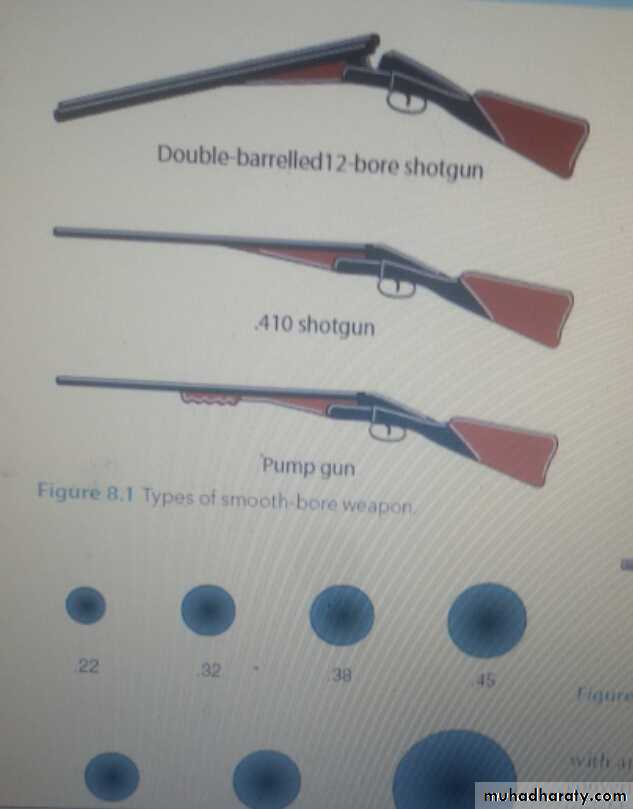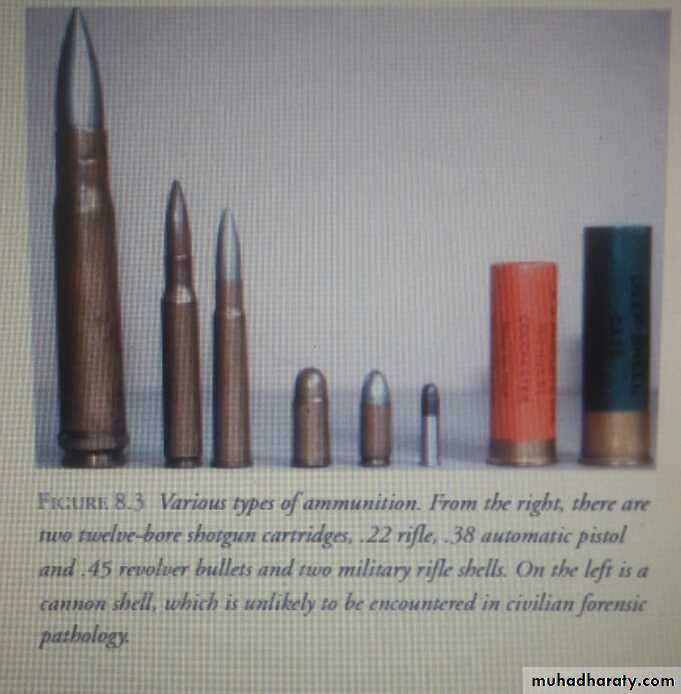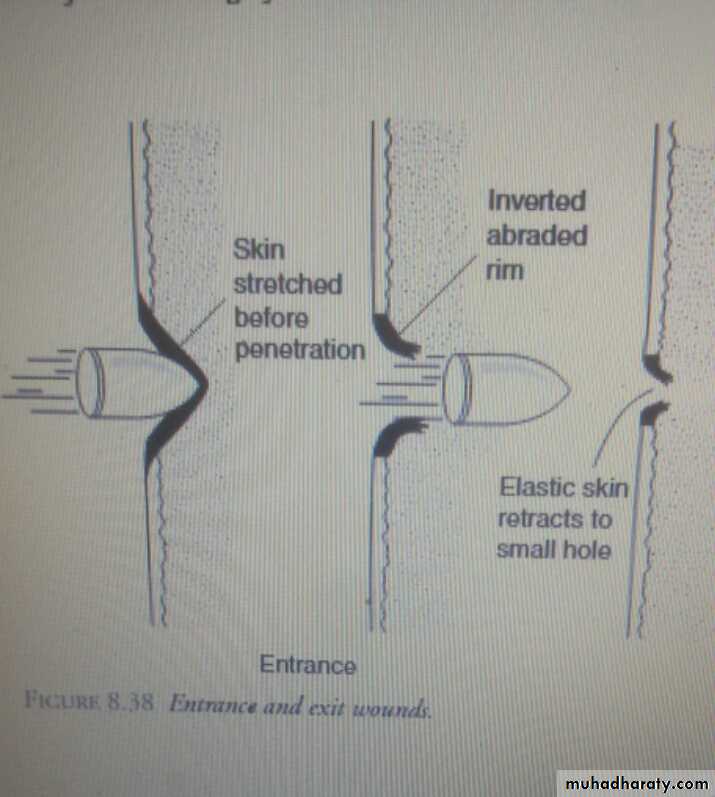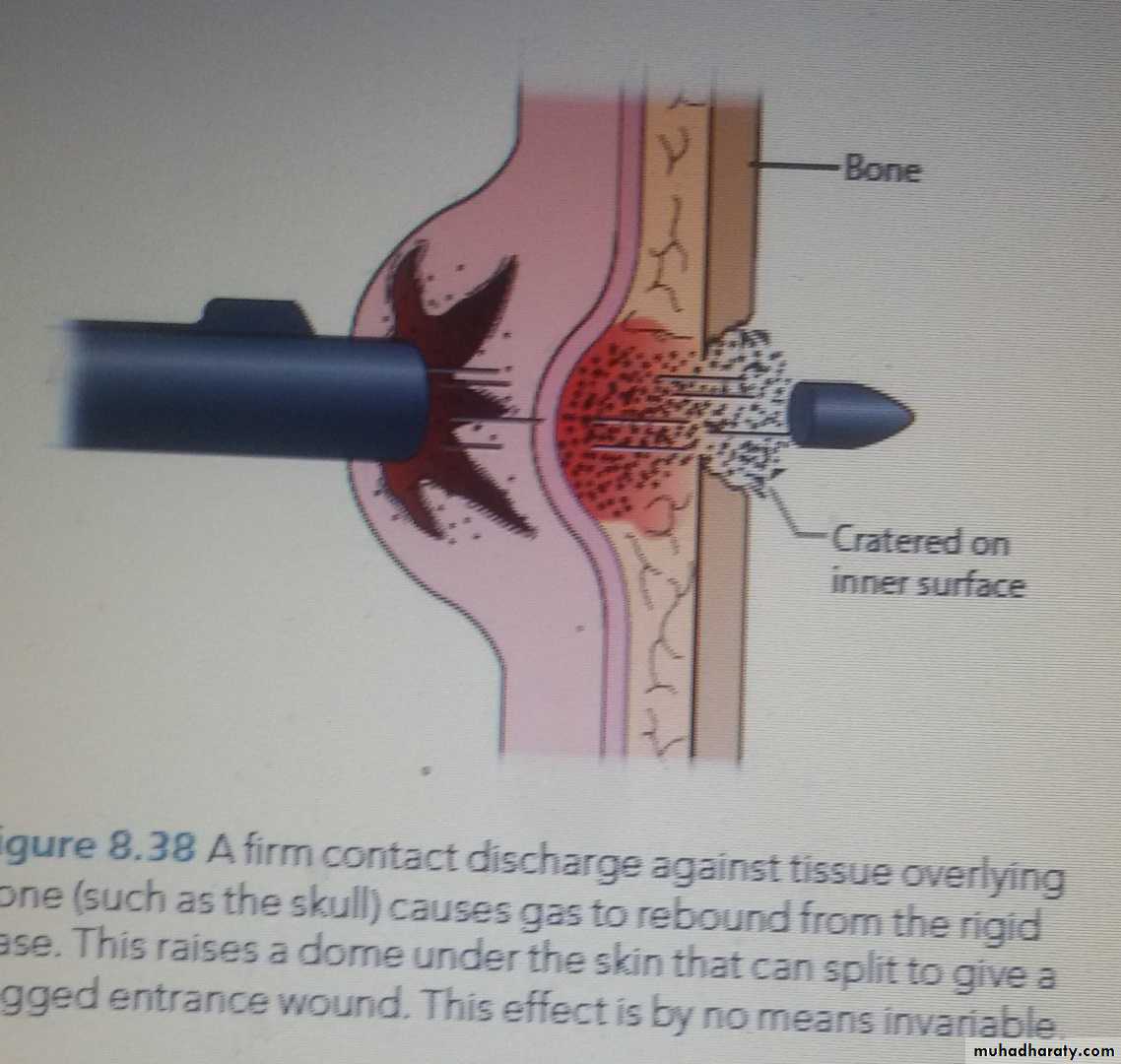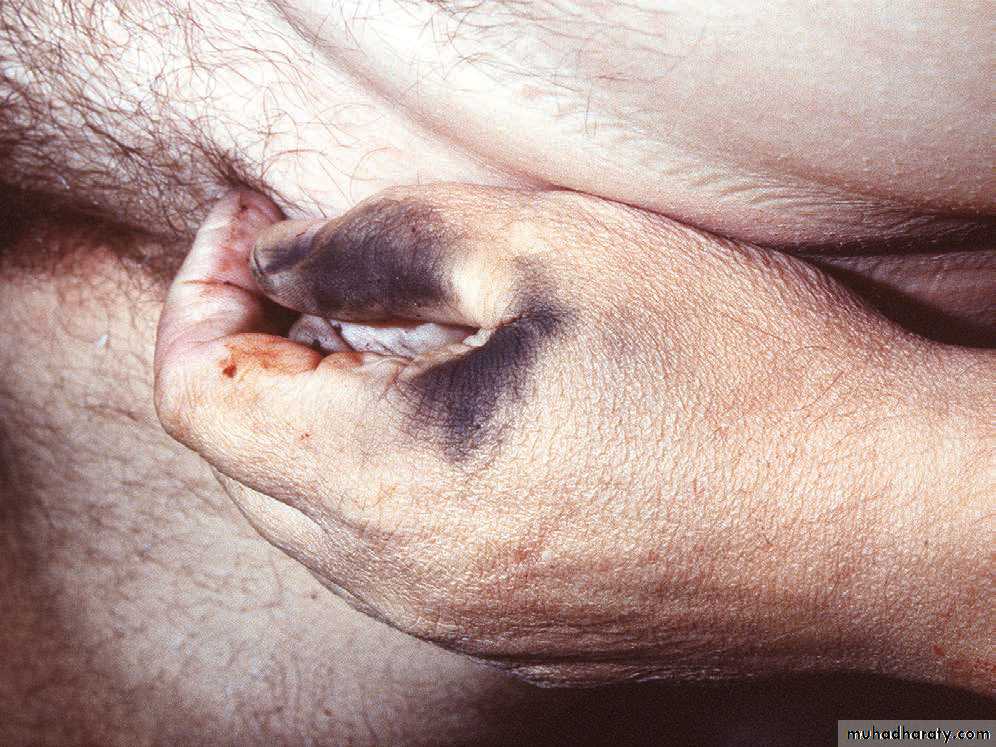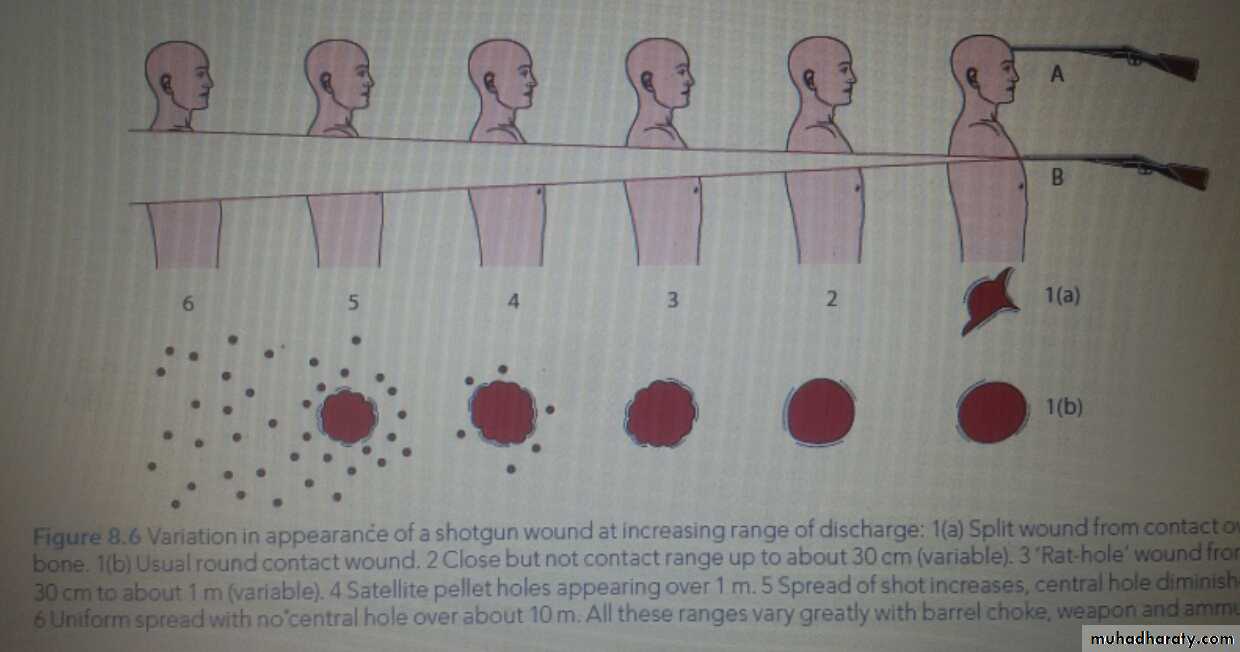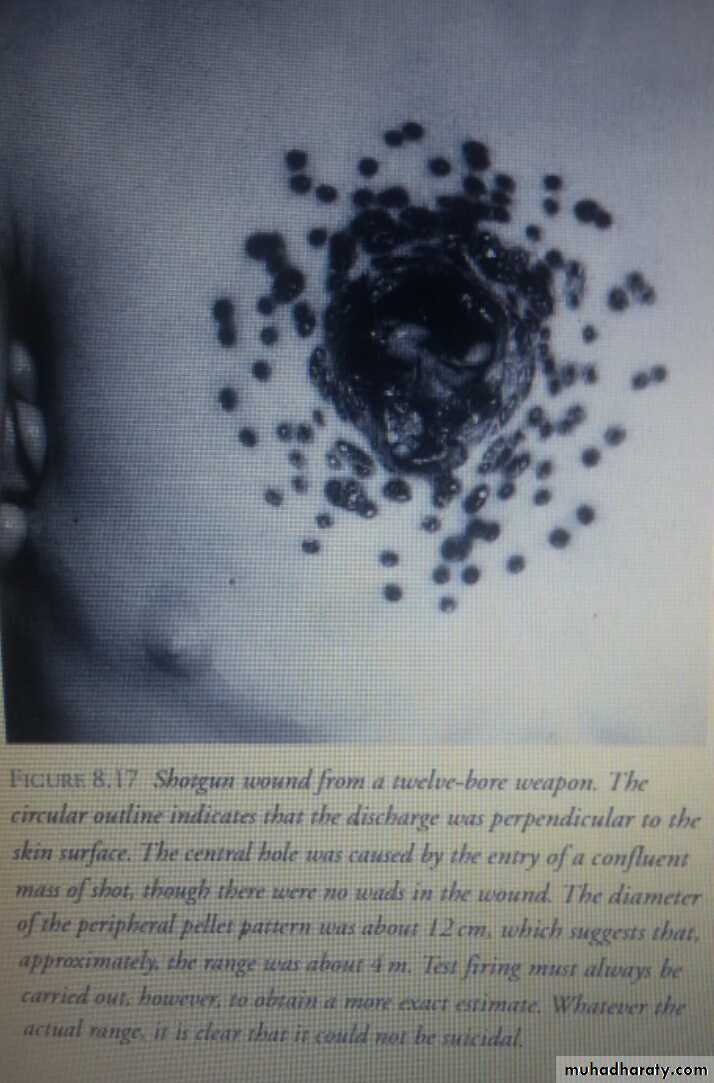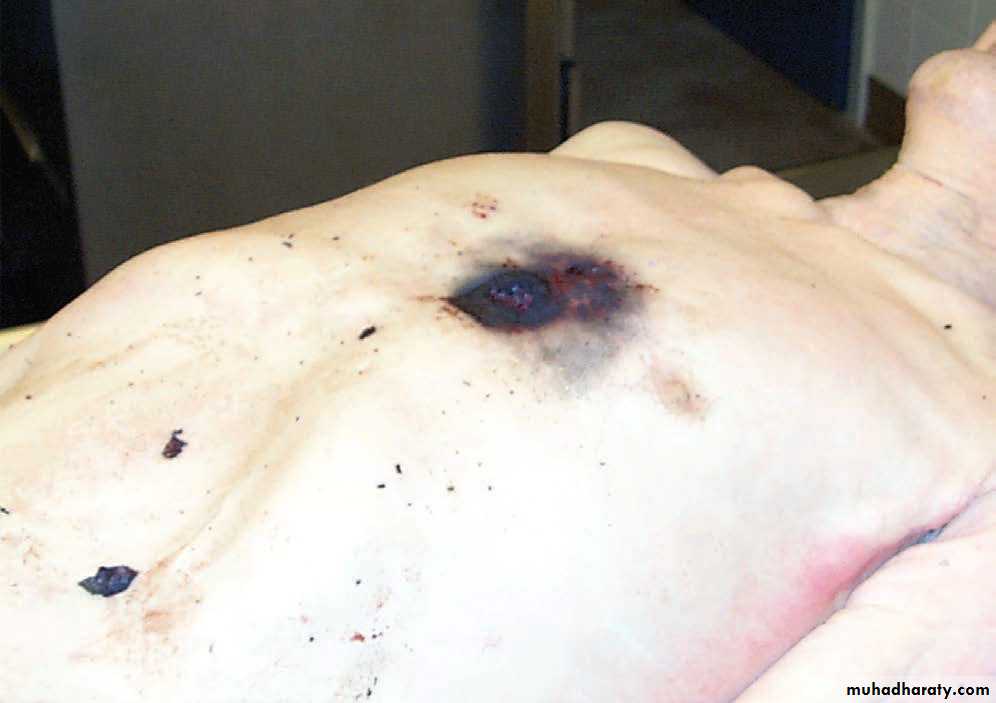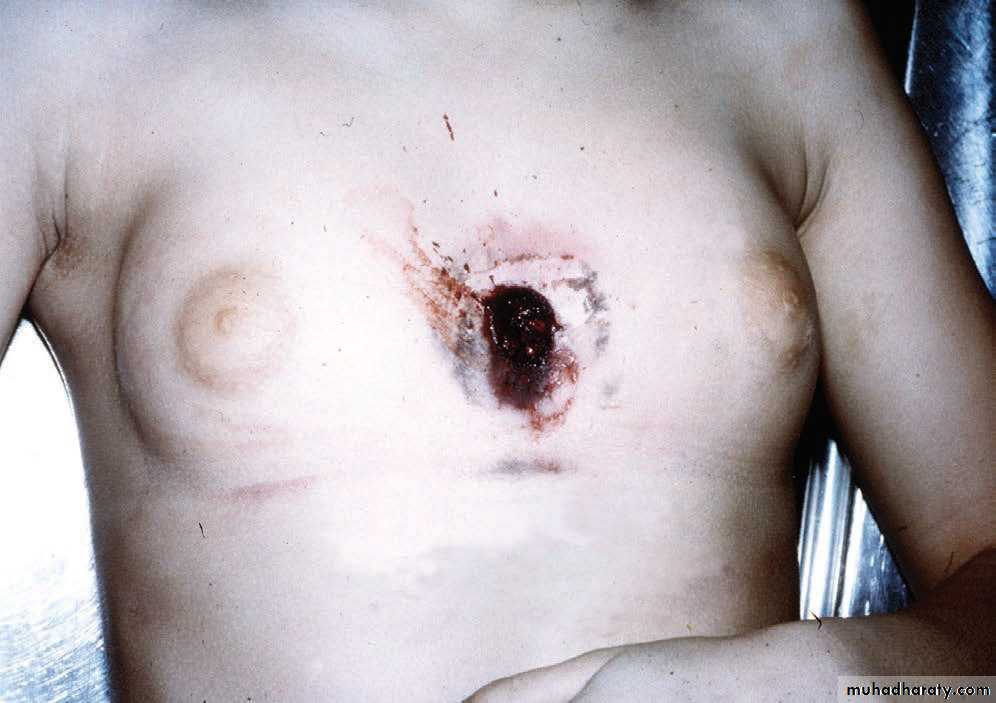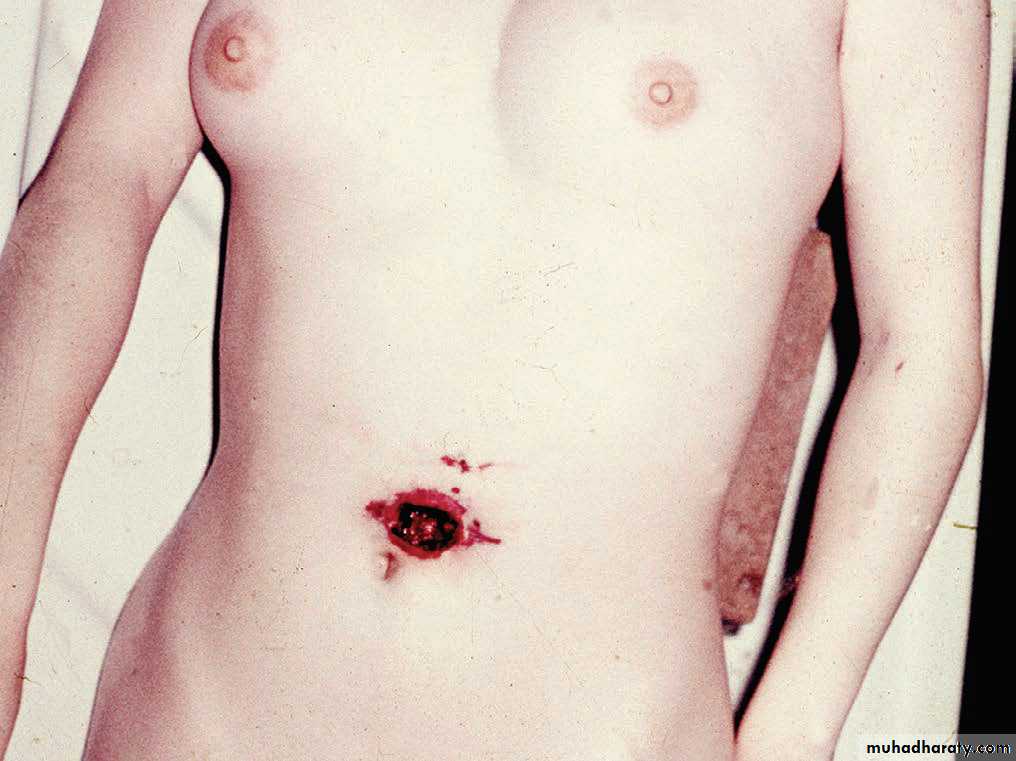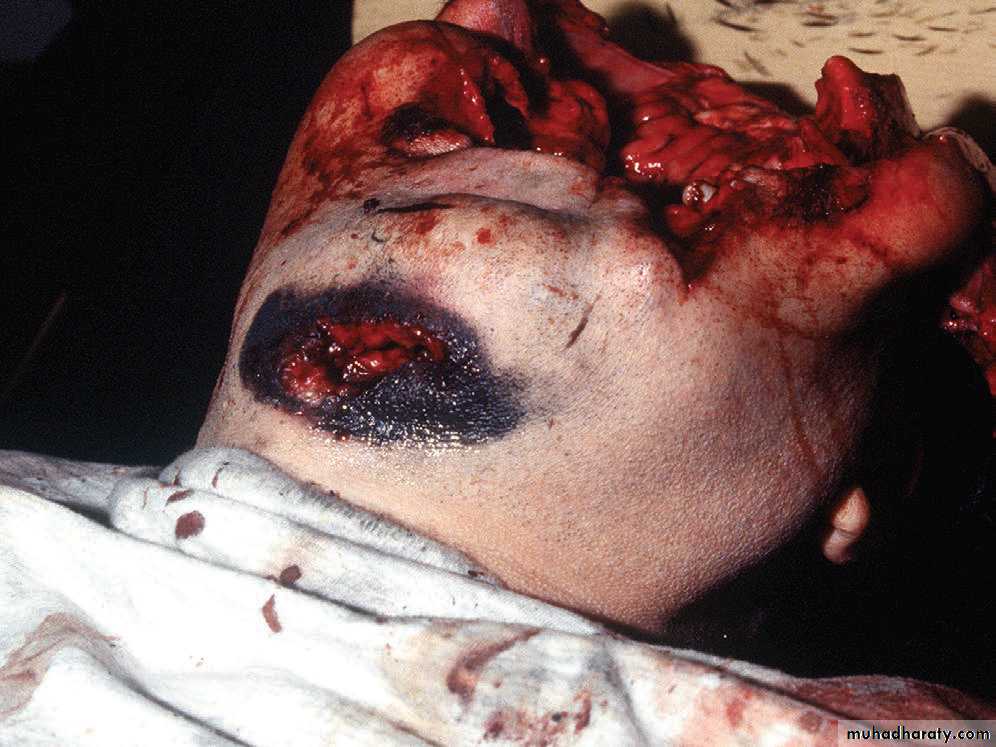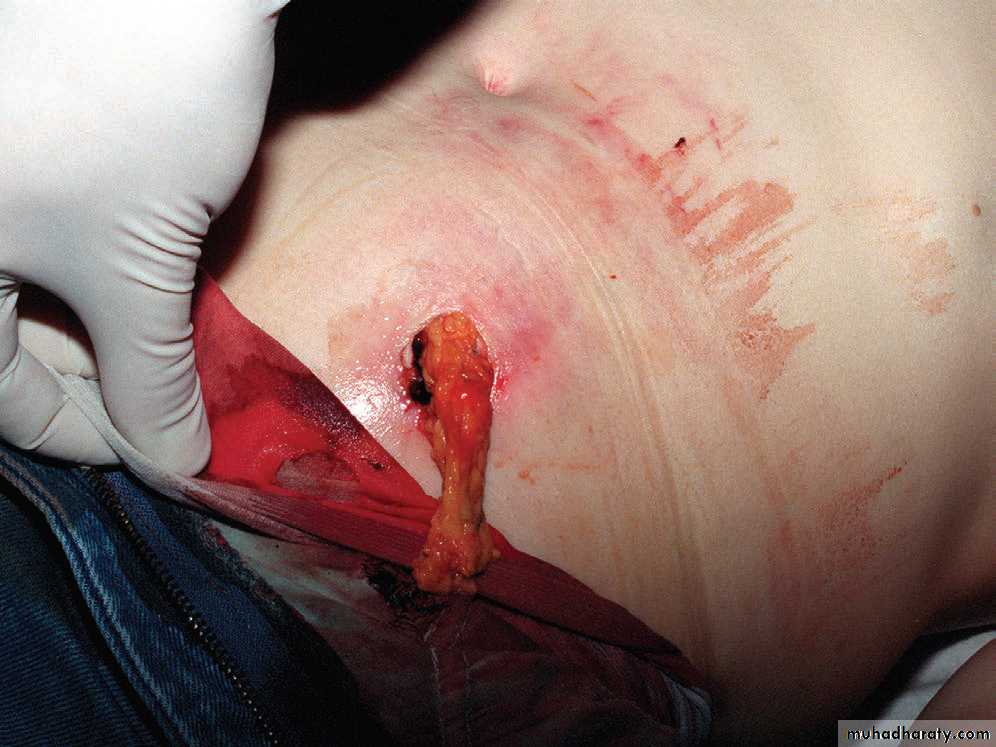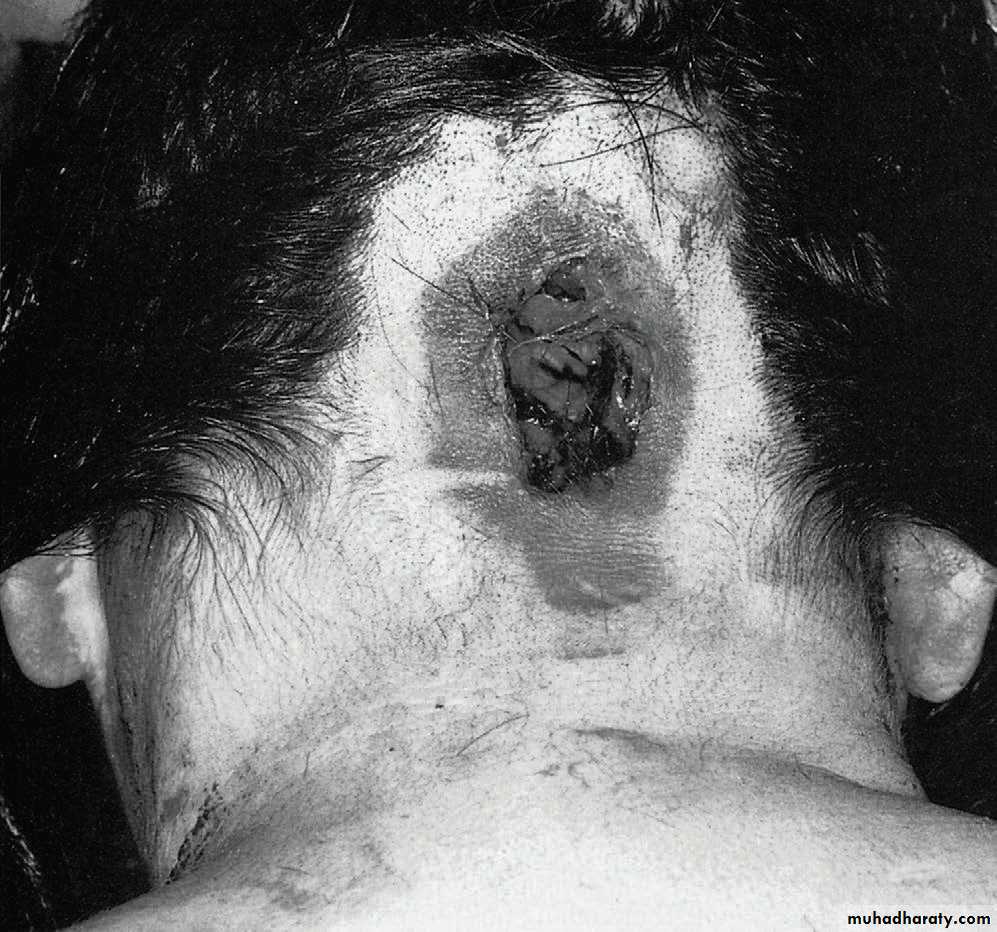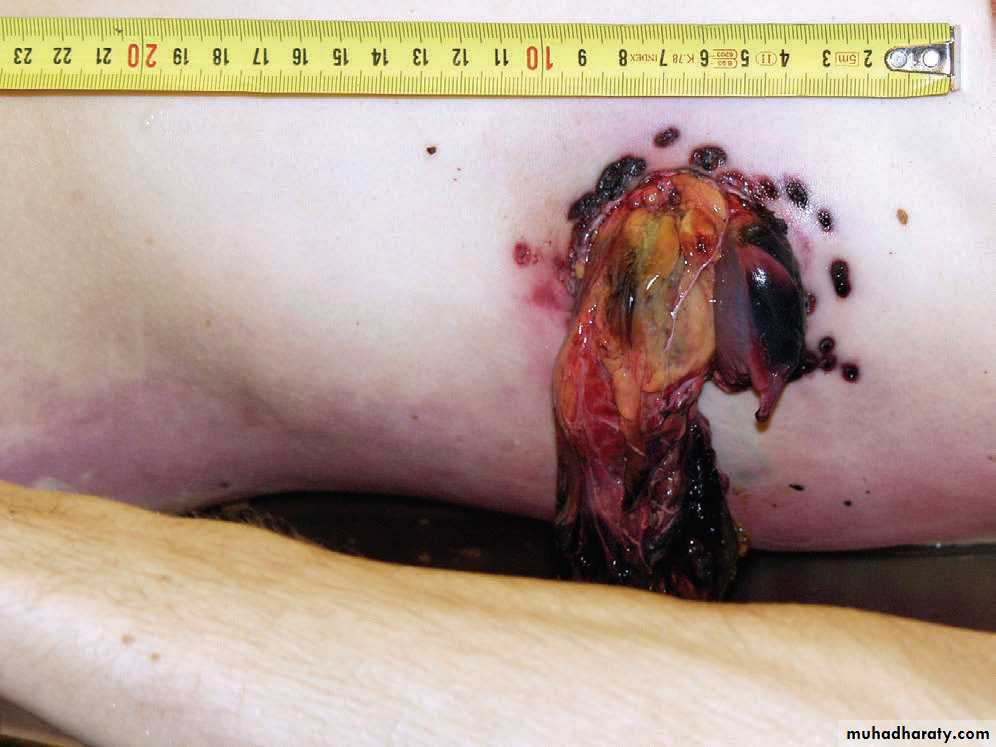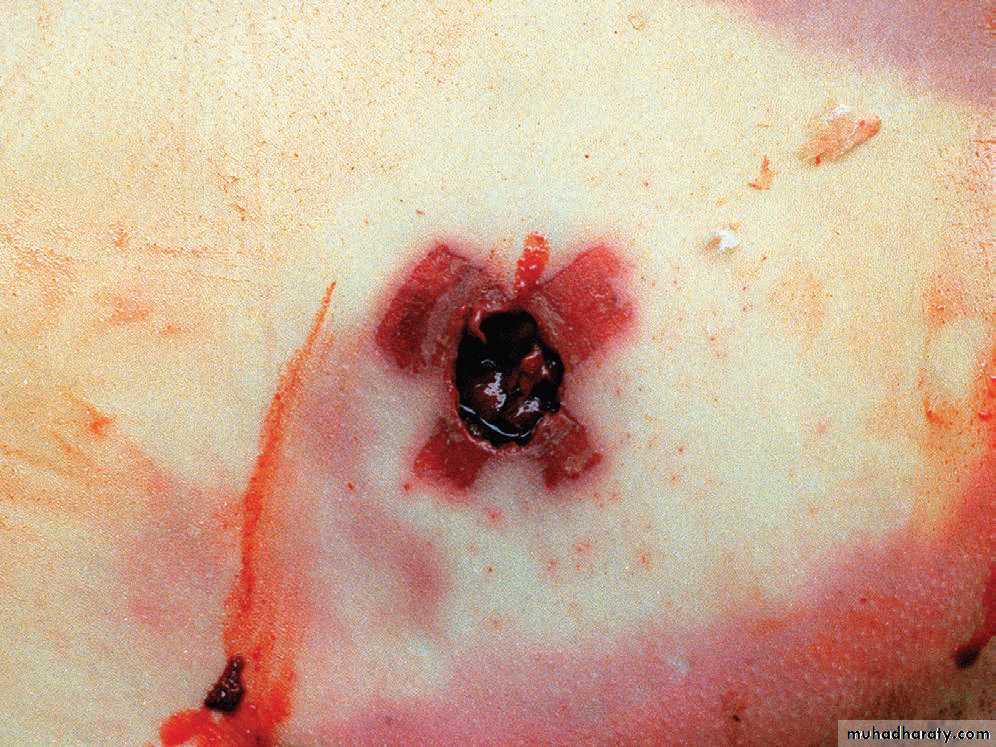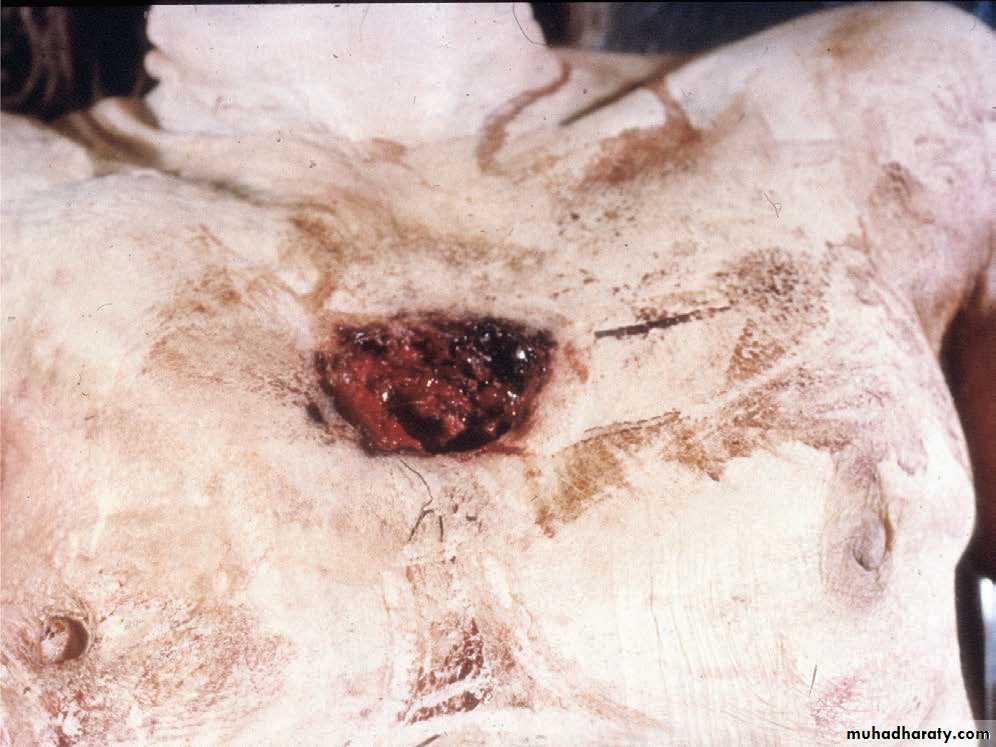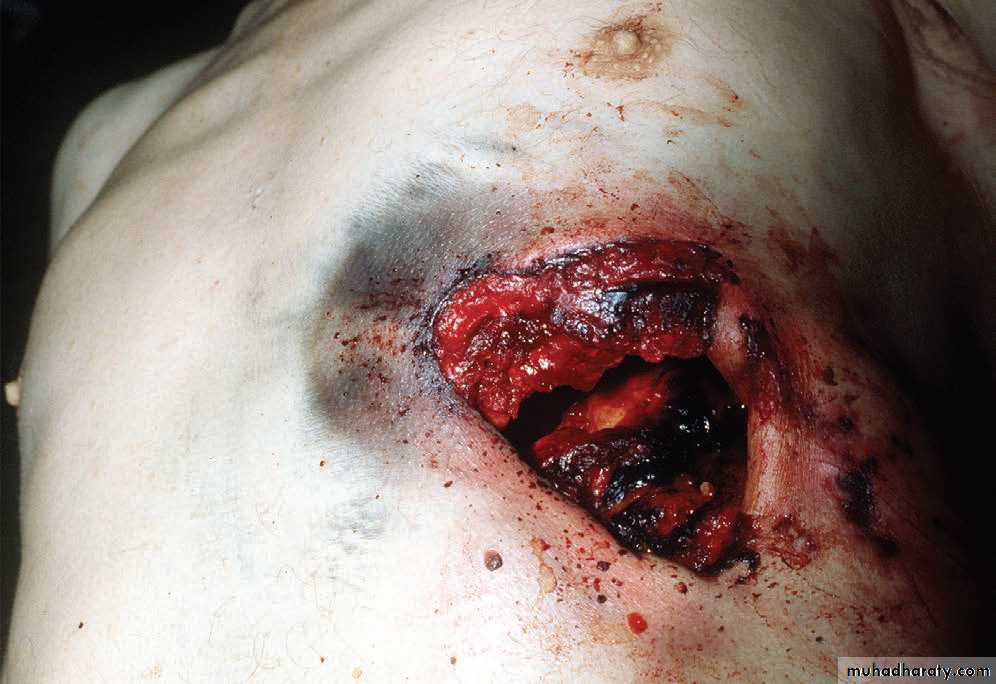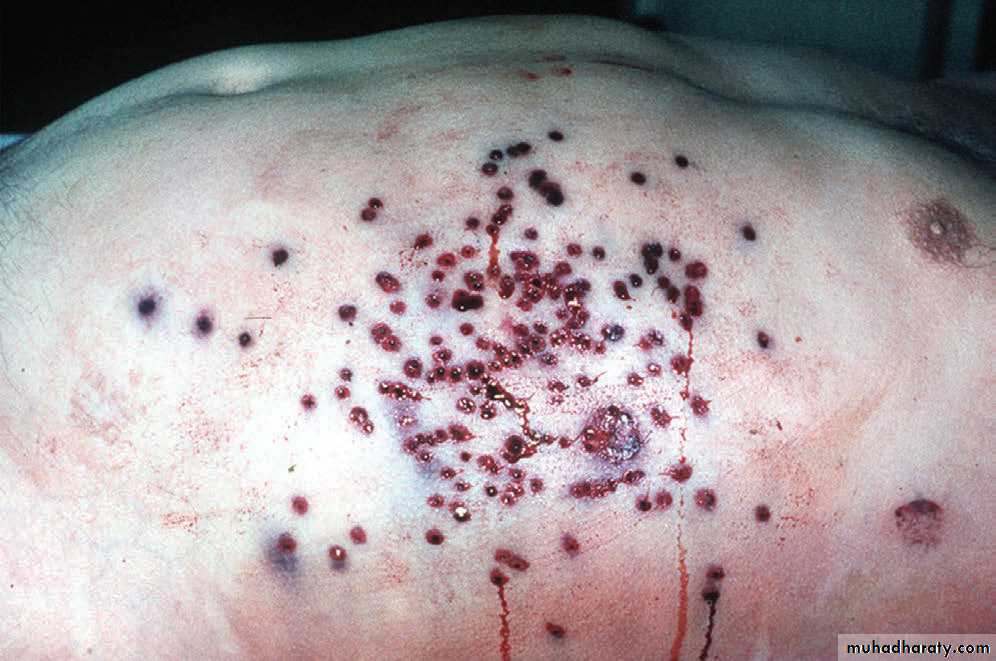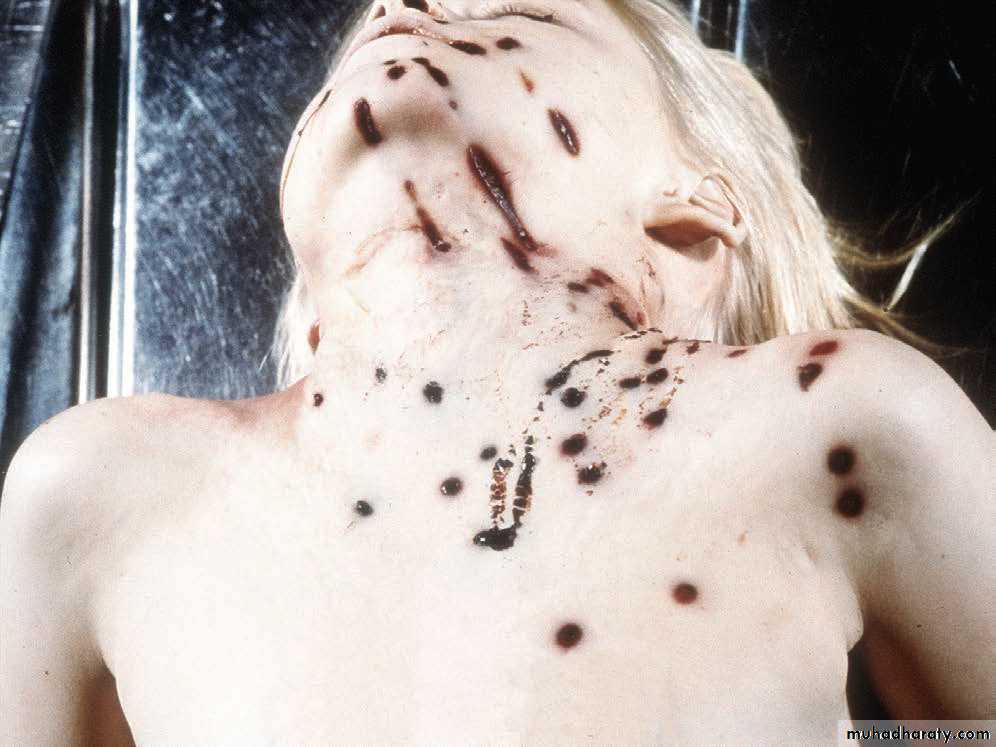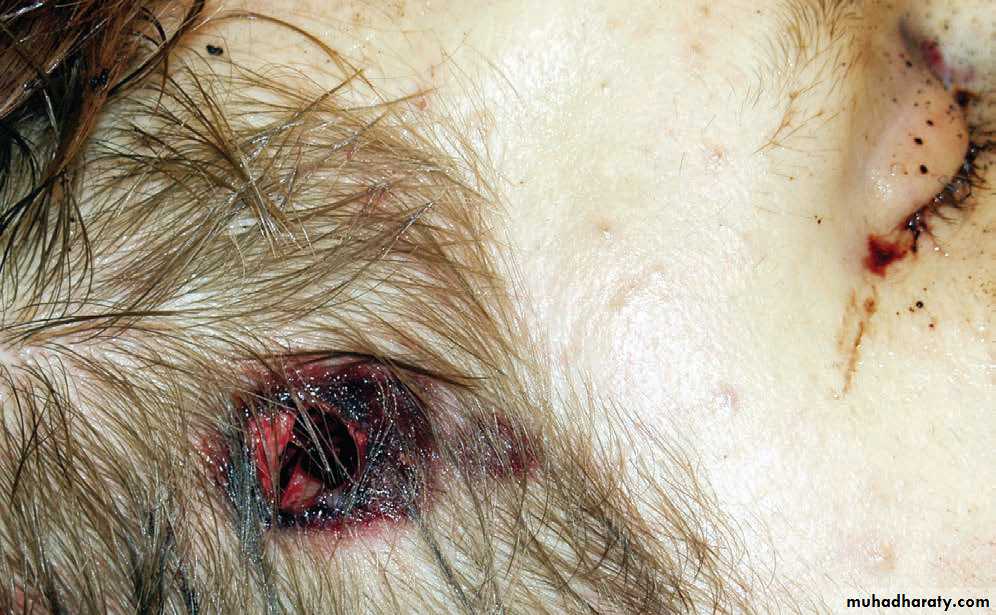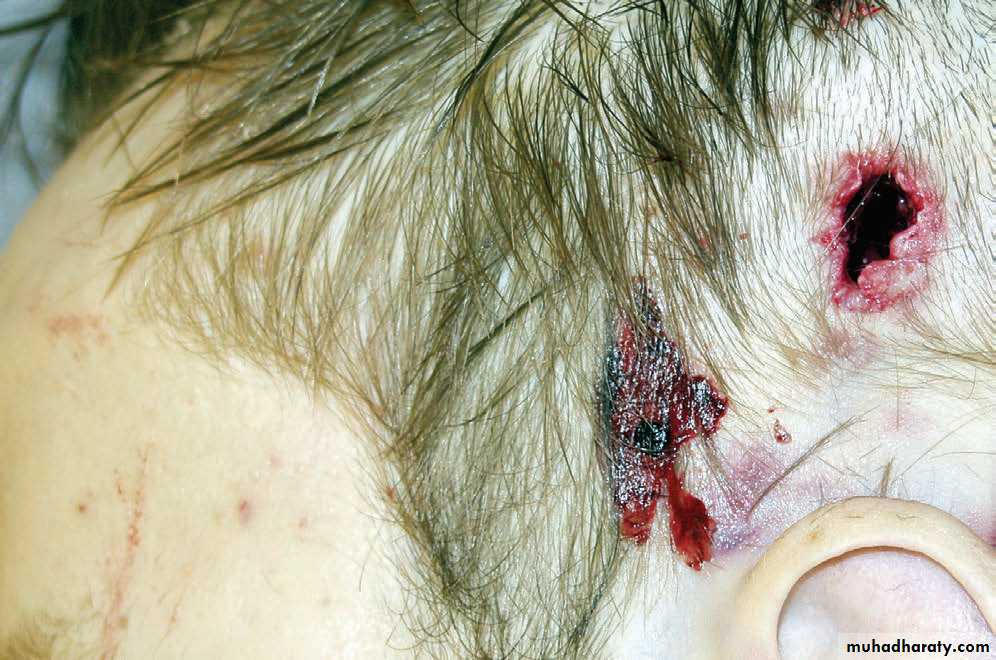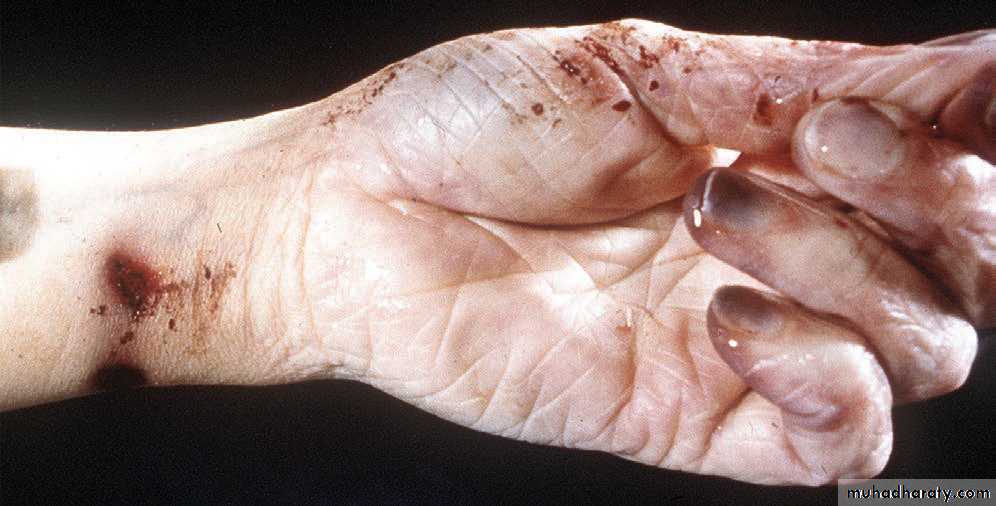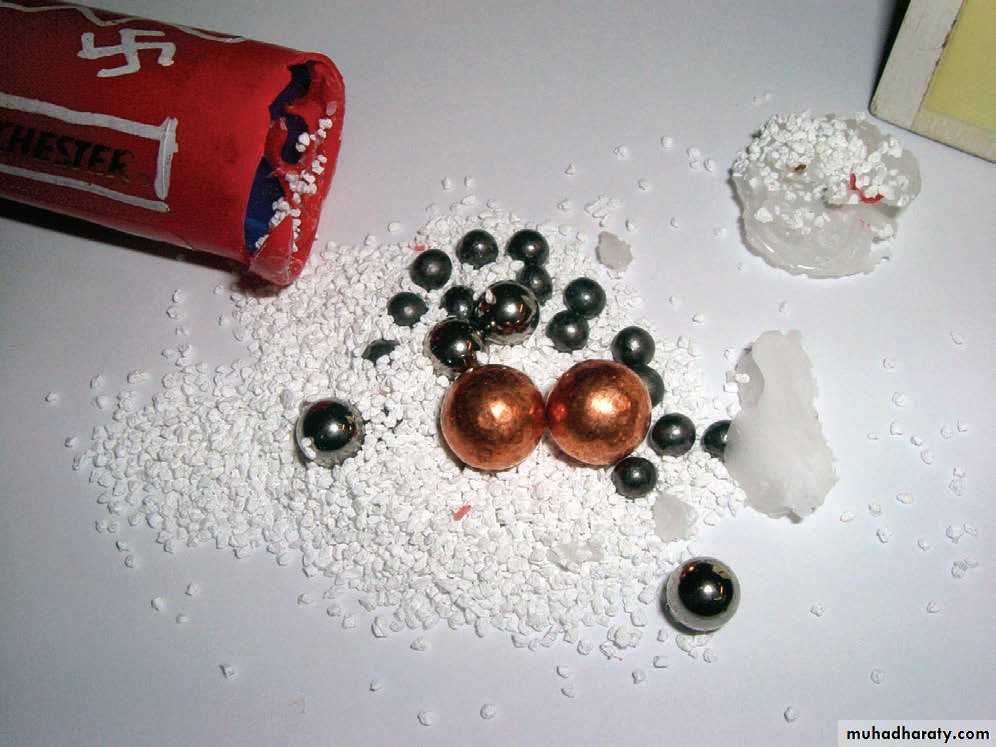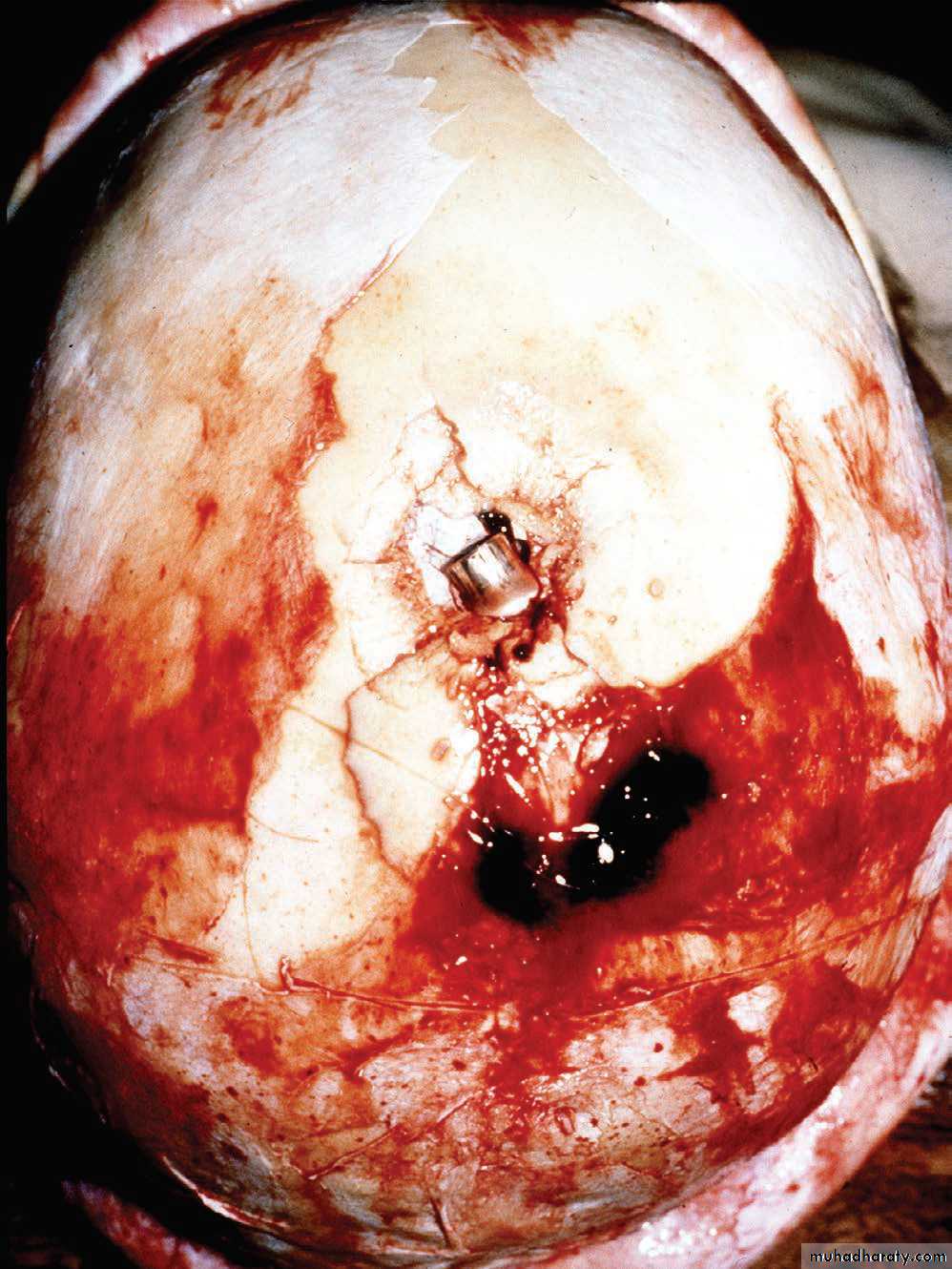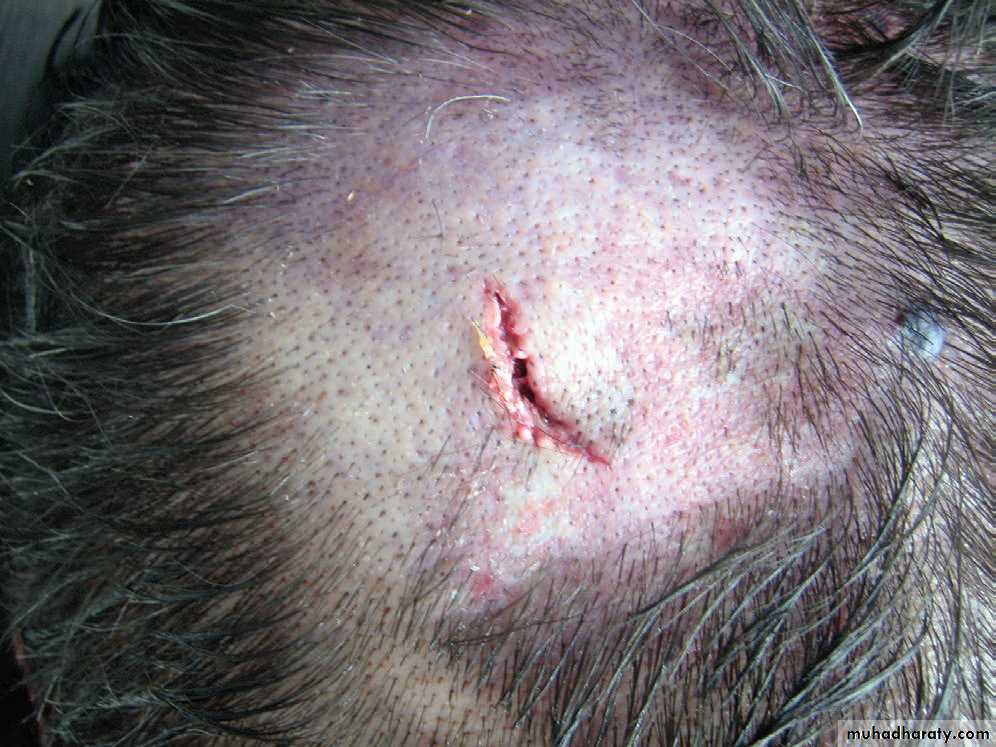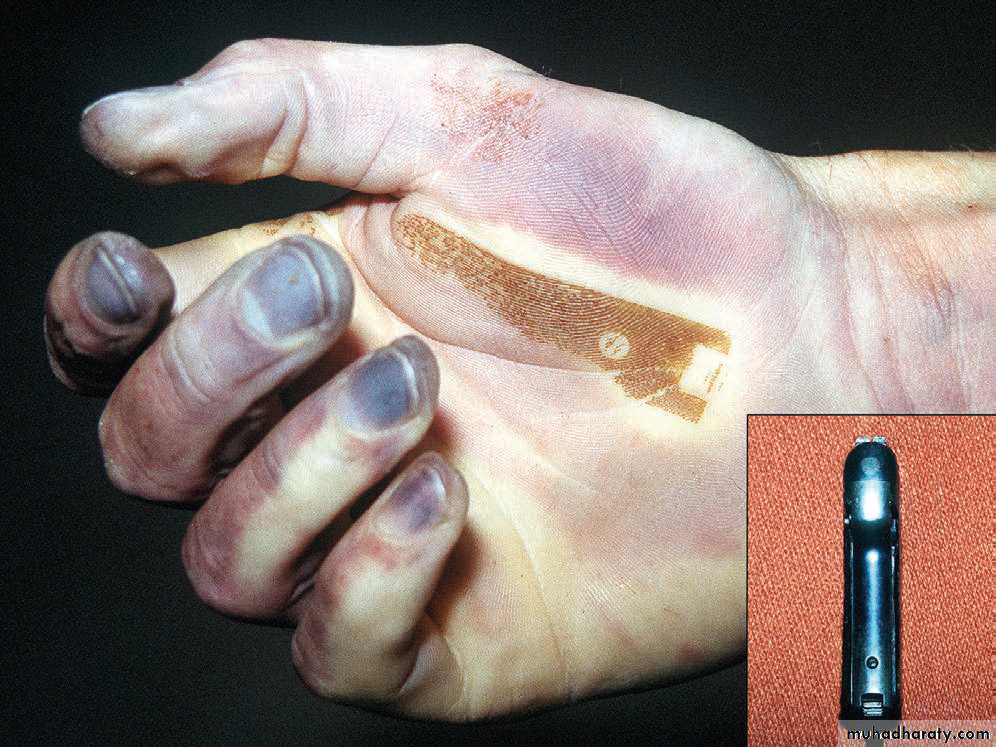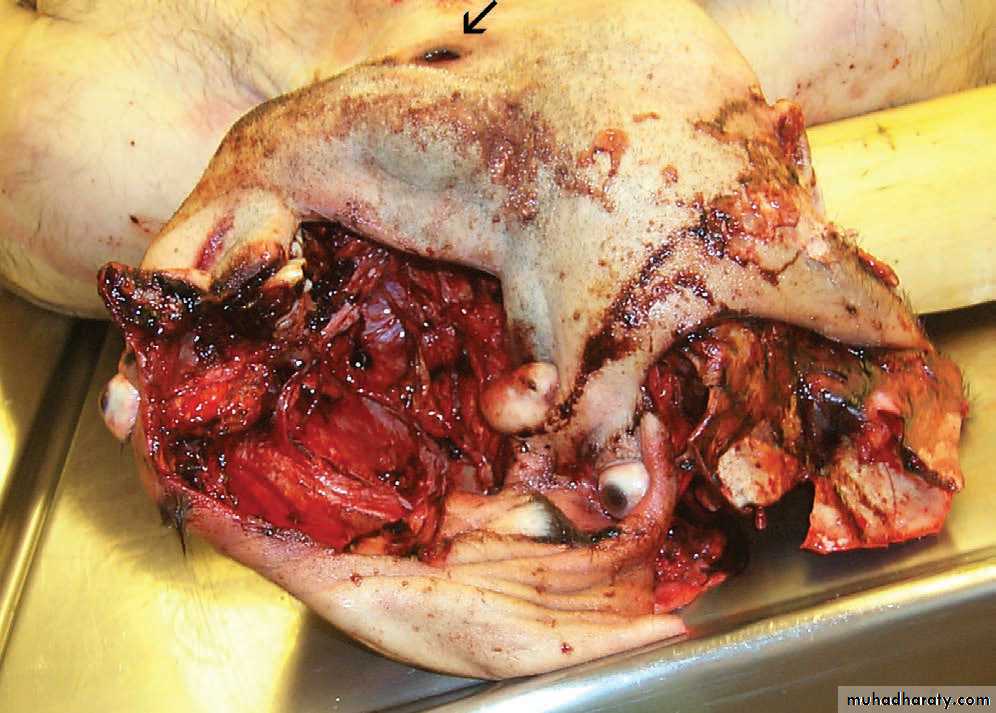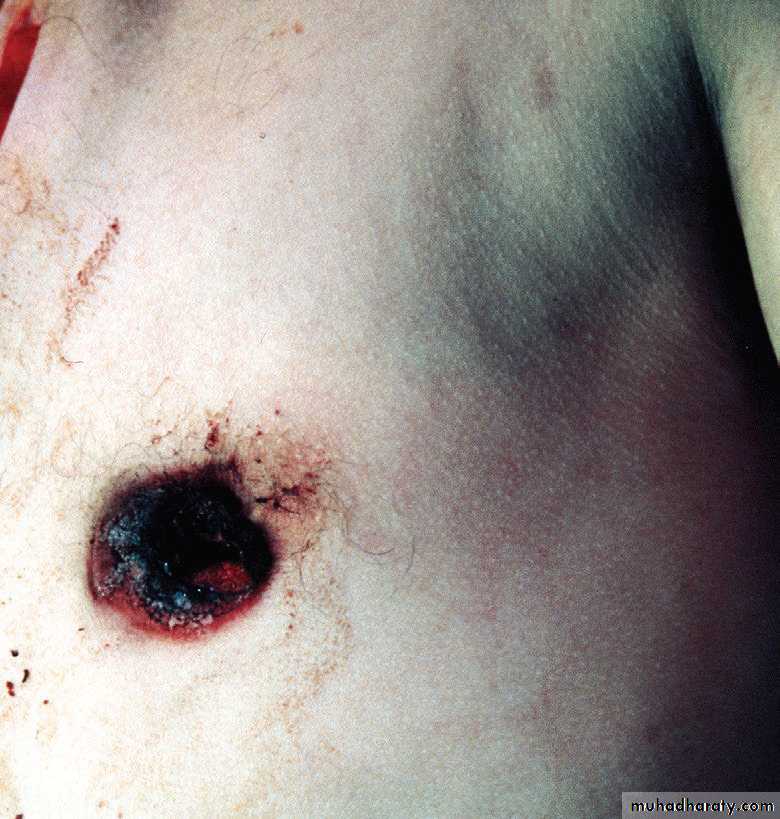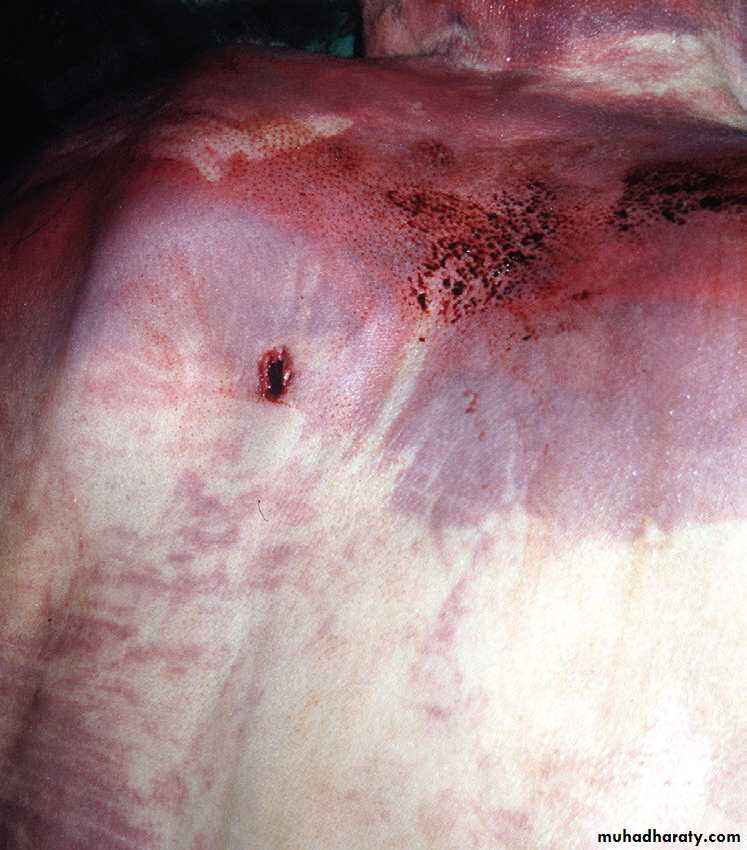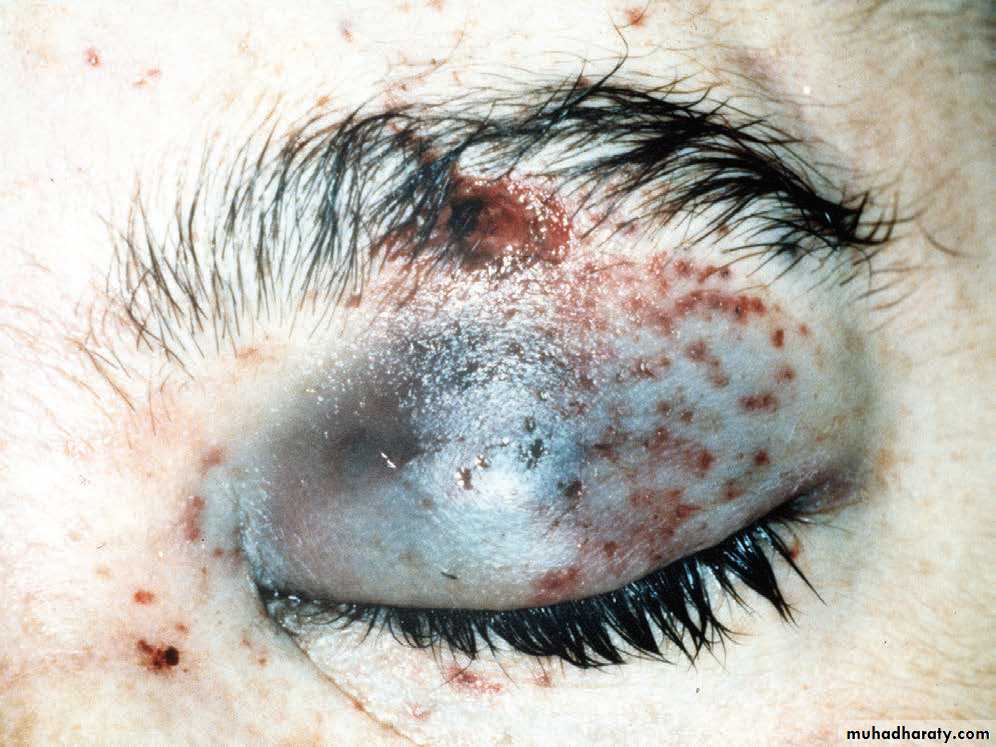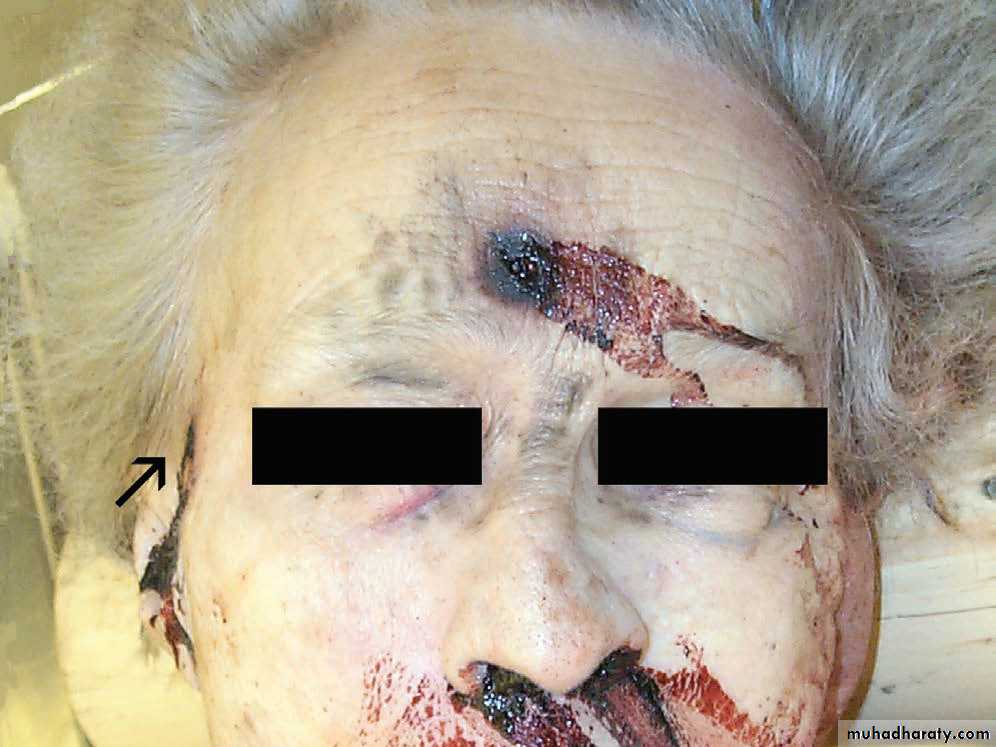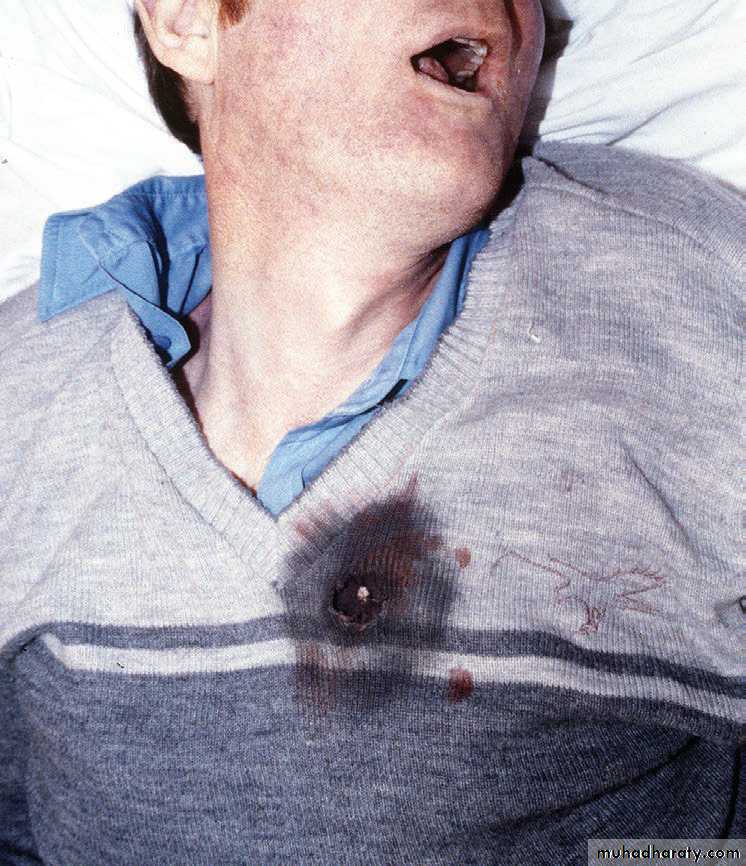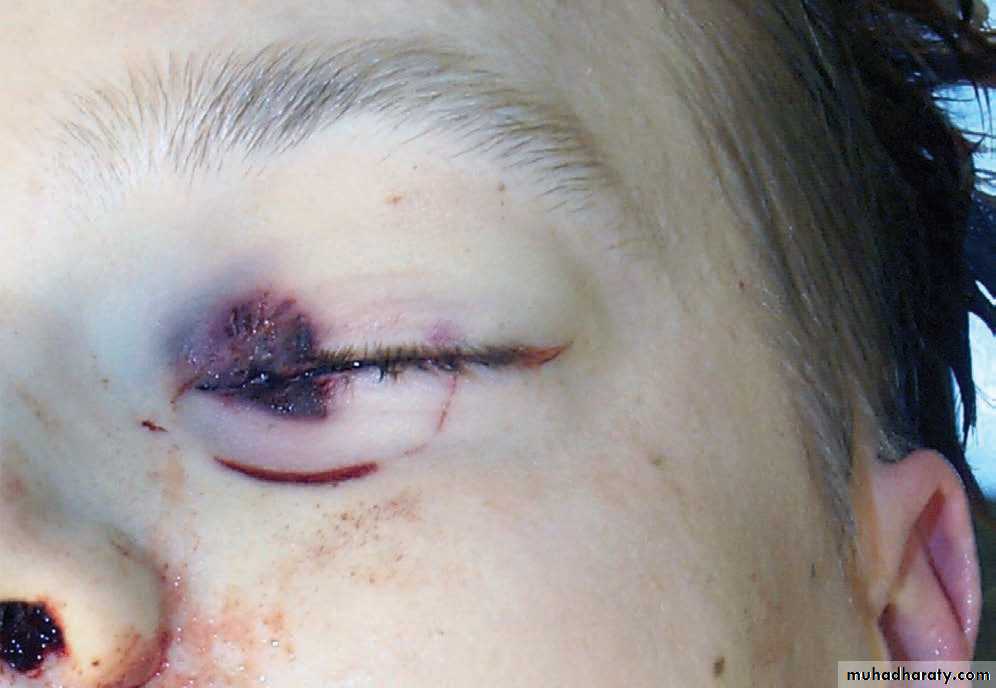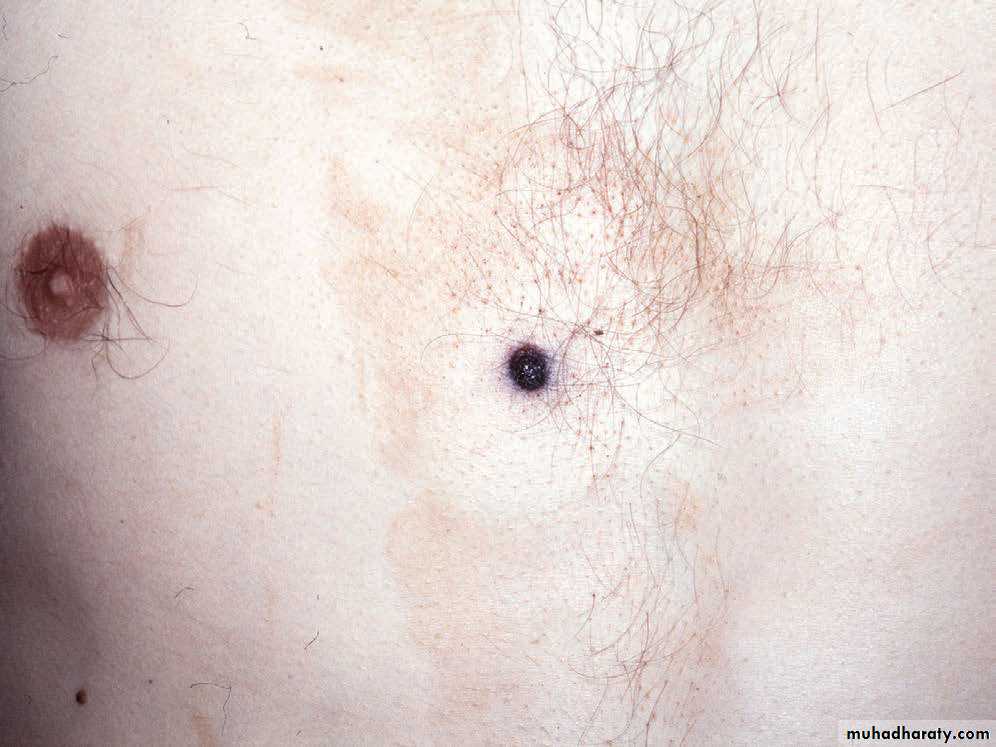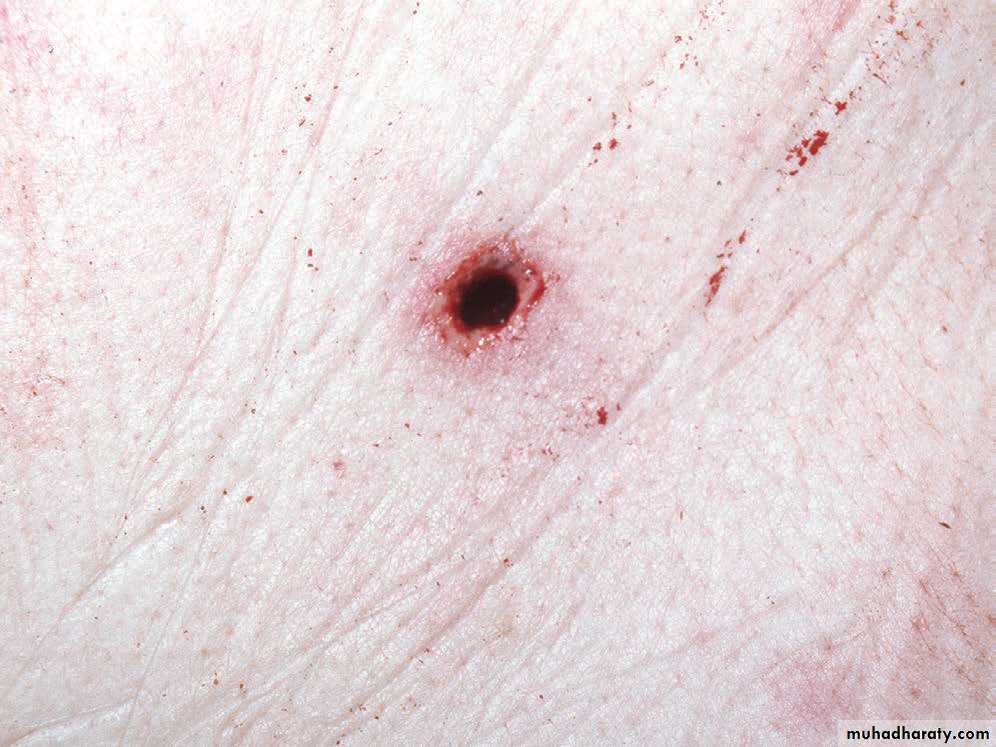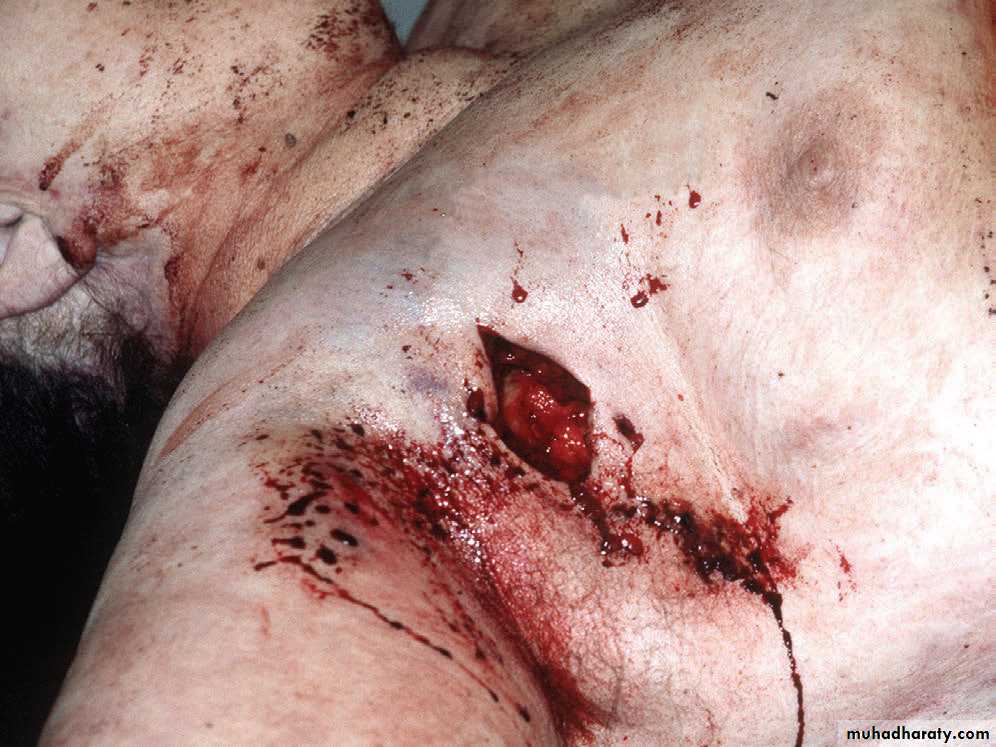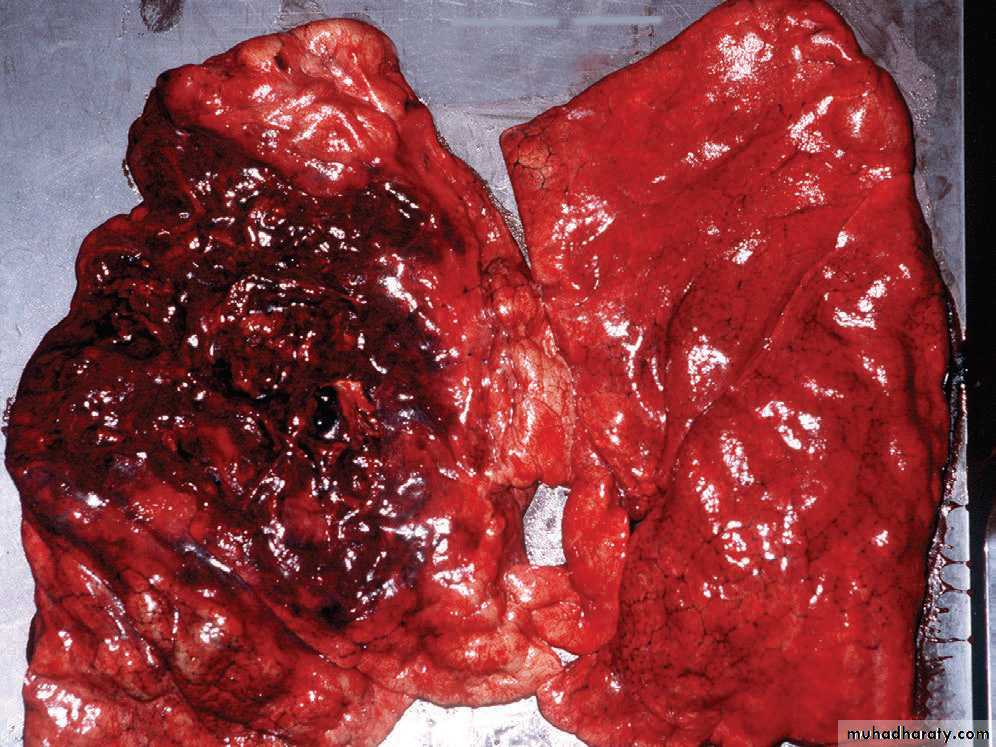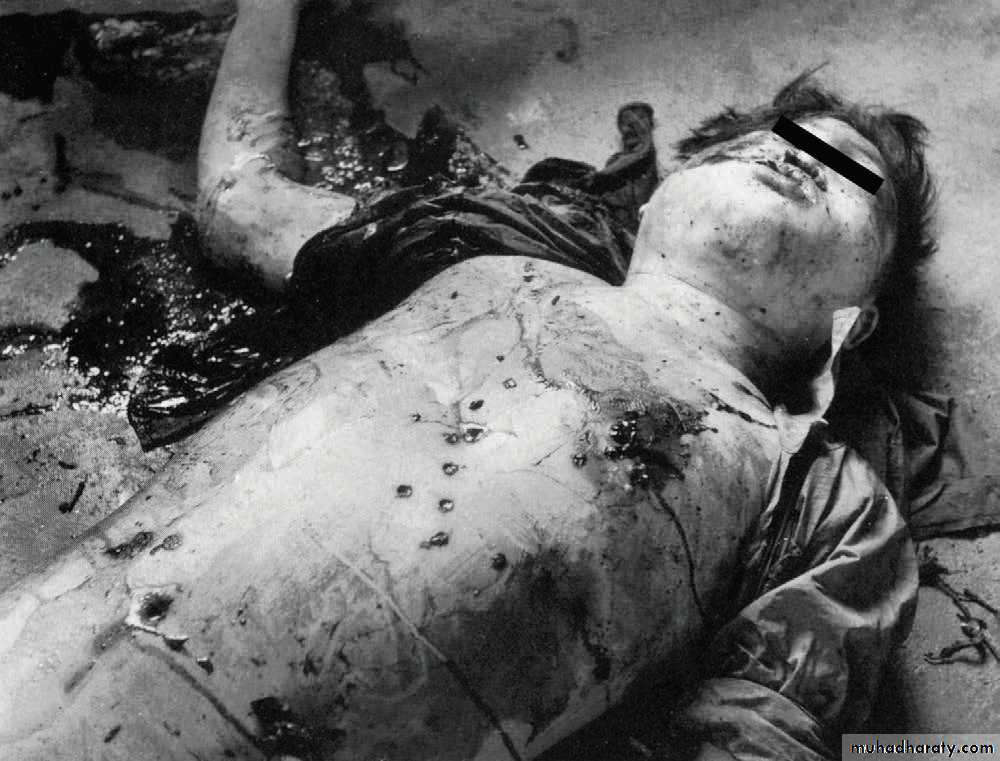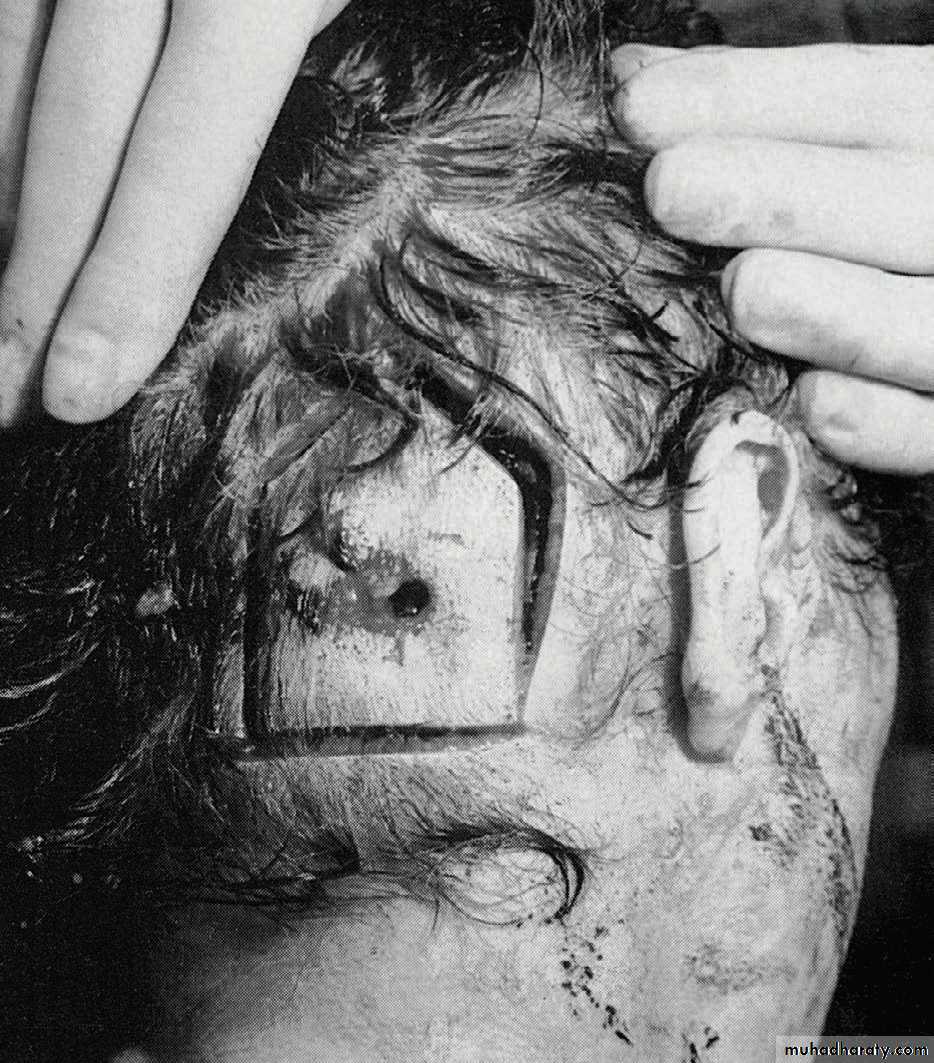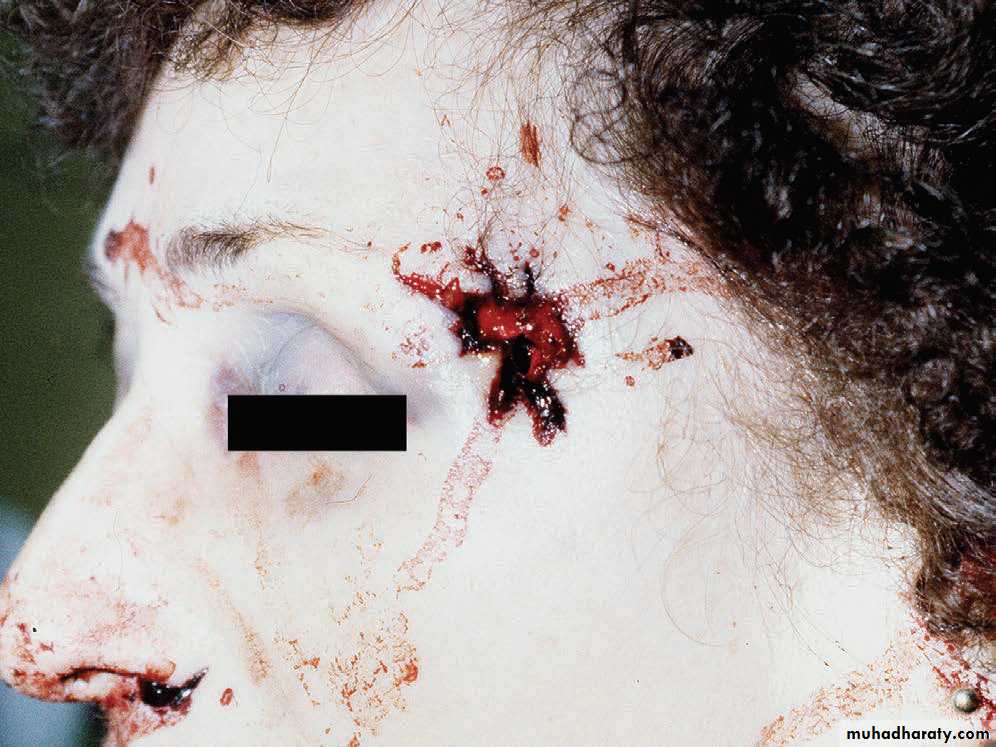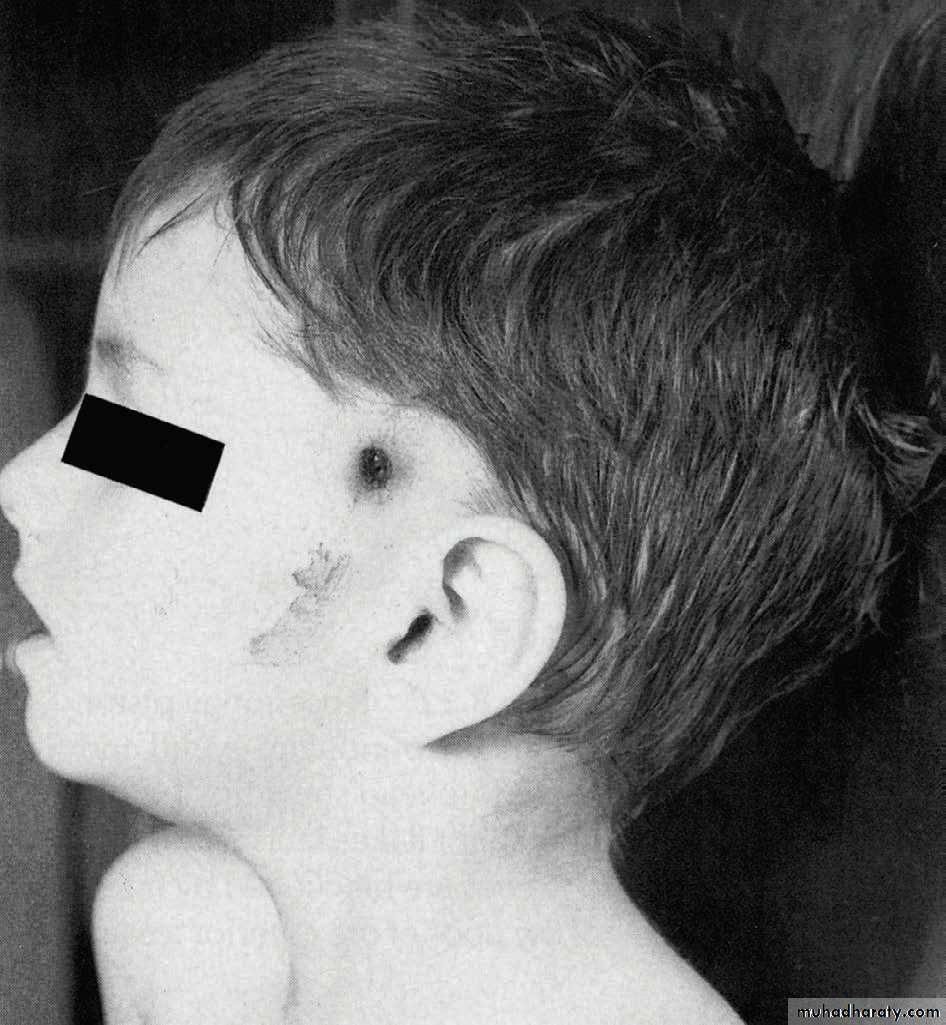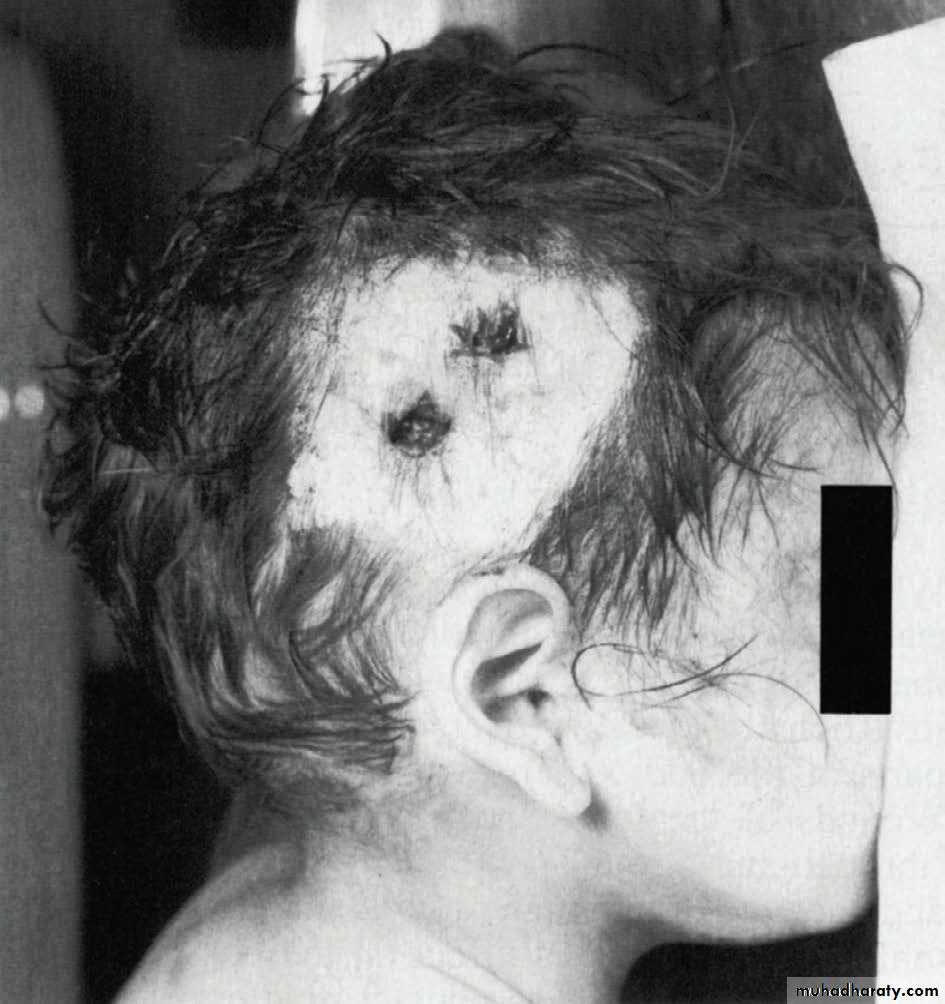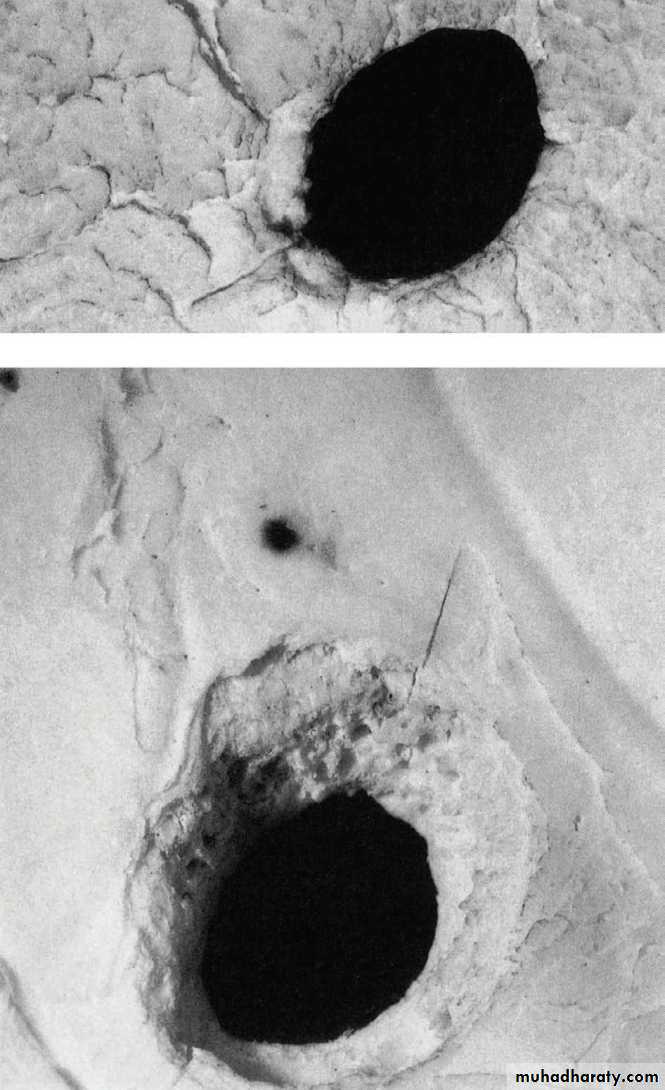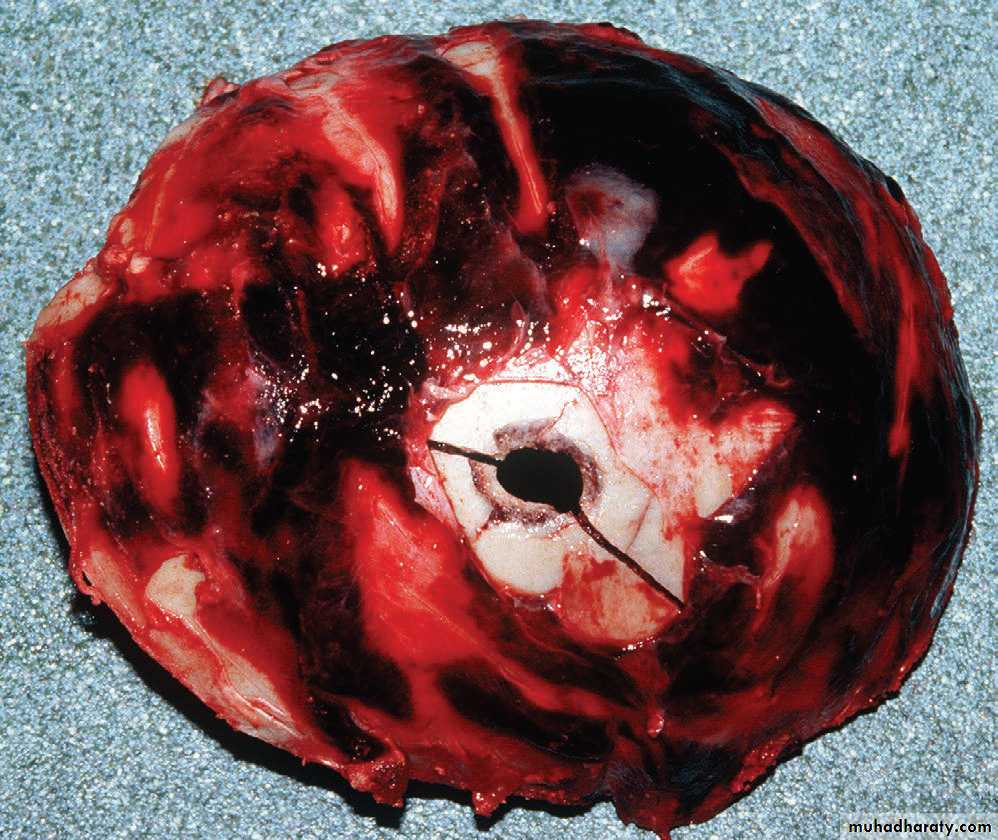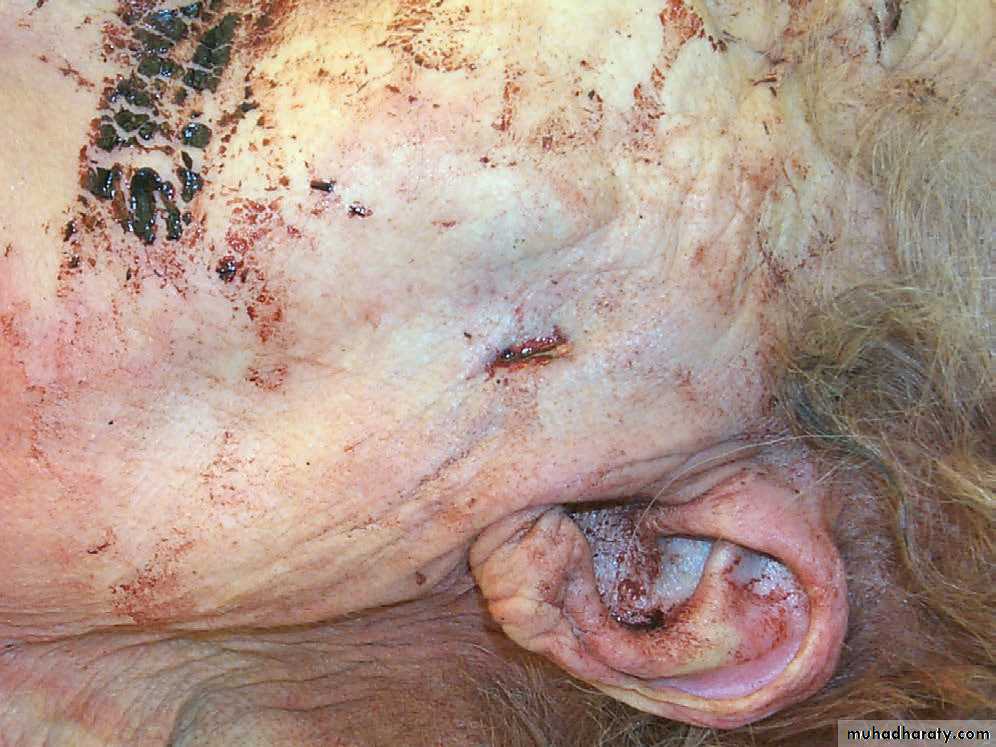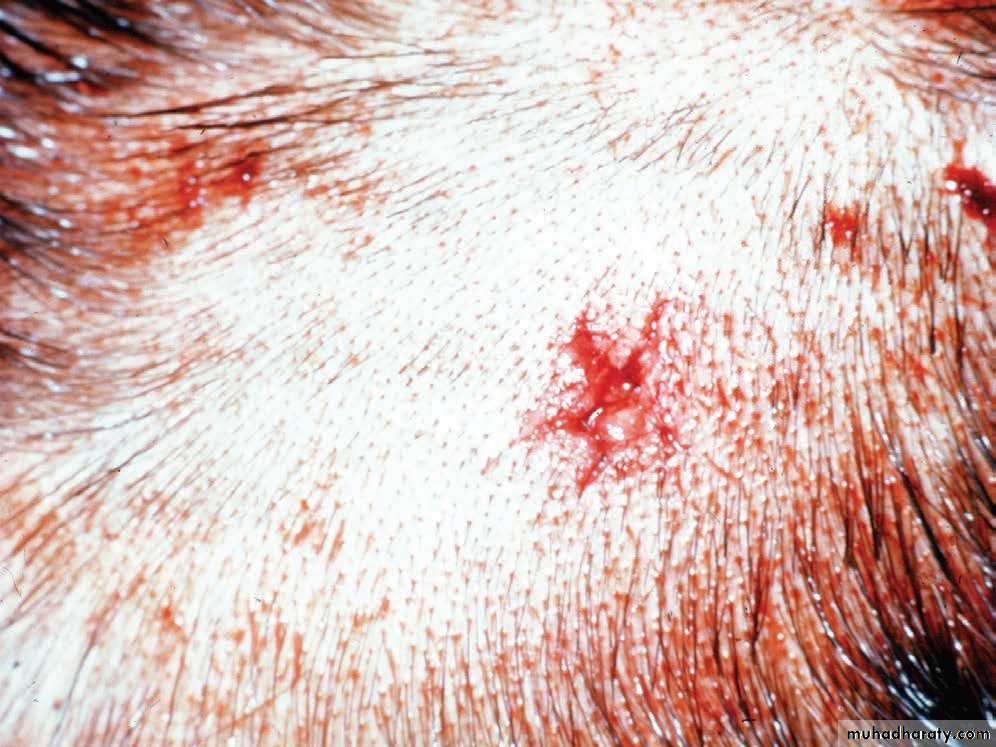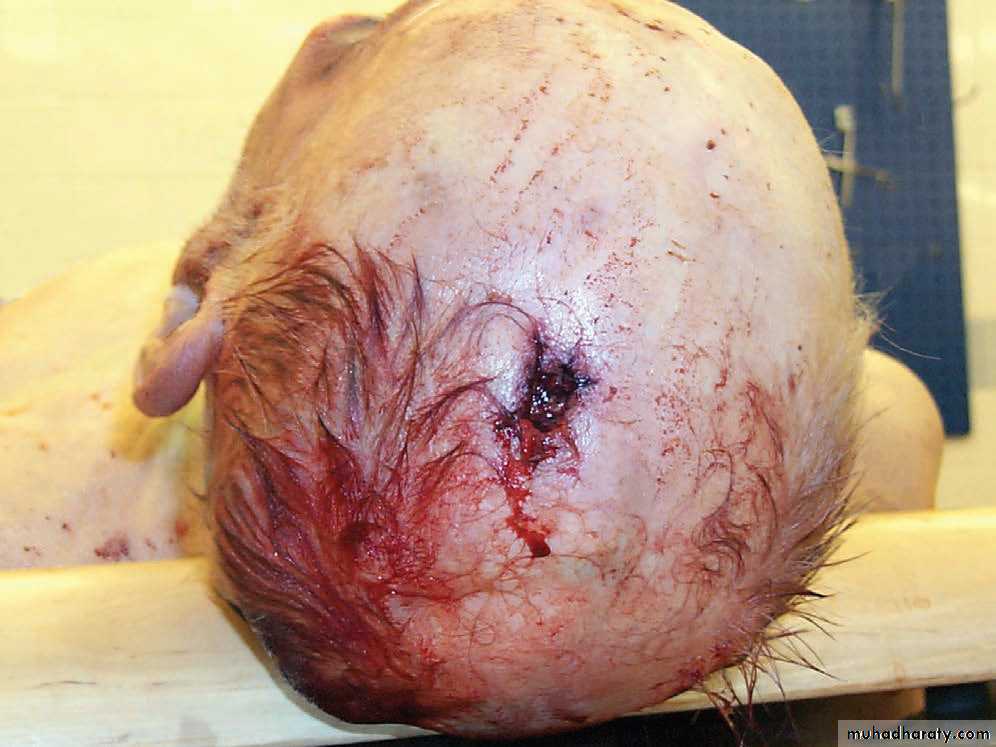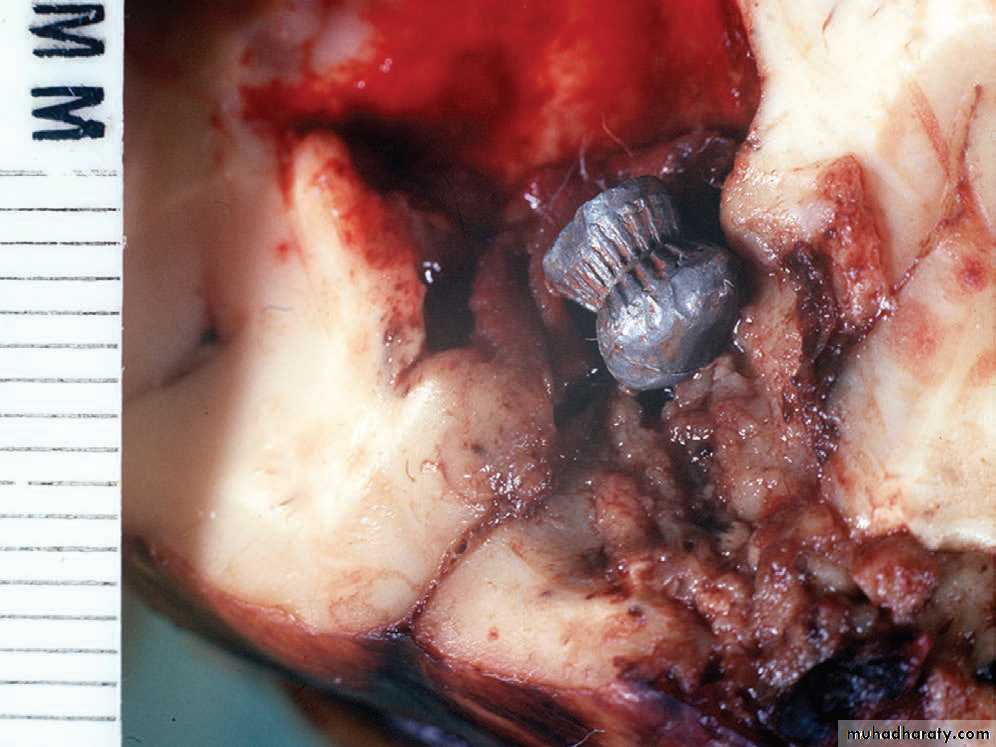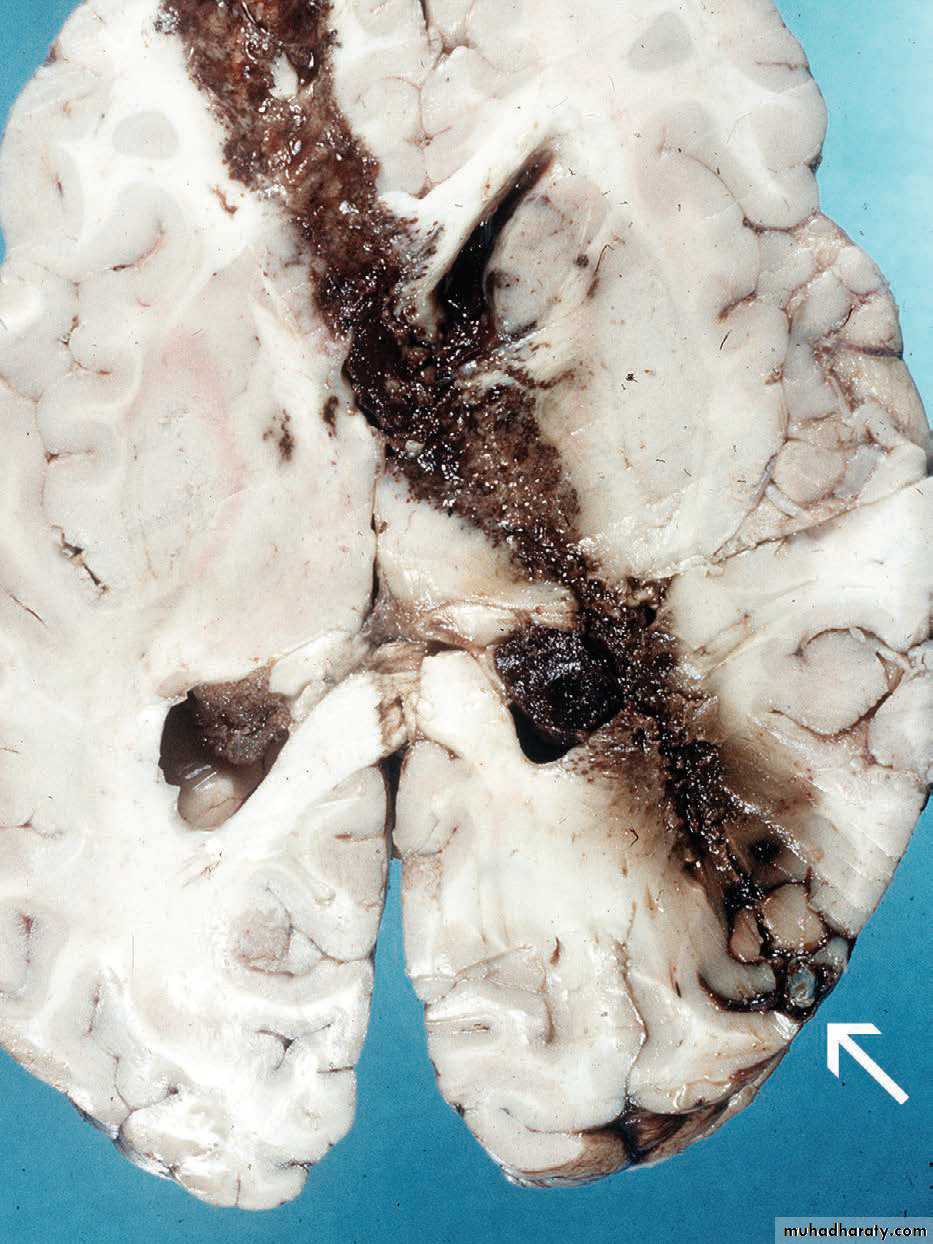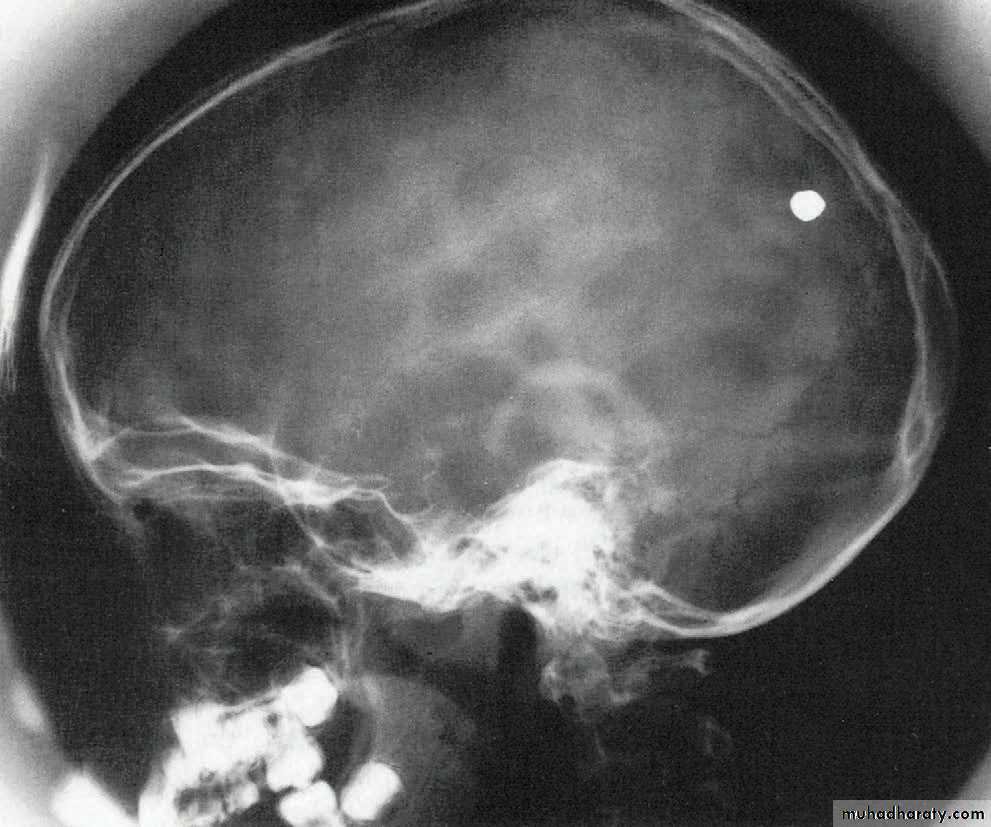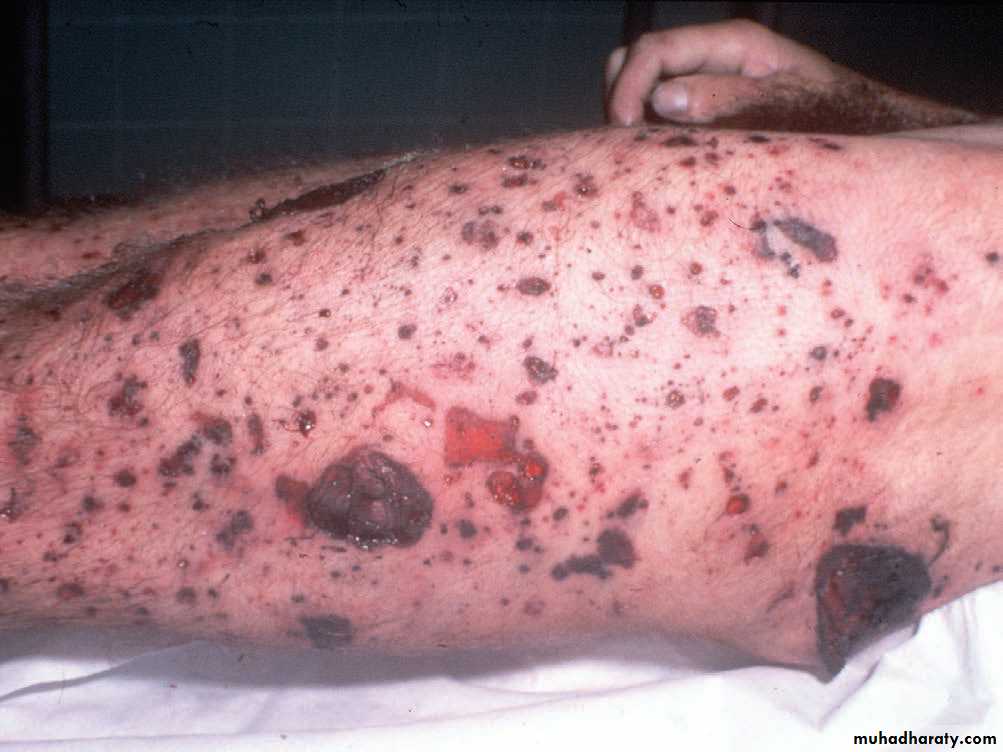Post-mortem change in the eye, the so-called ‘tache noire’. These are brown areas of scleral drying caused by failure of the lids to close after death.
Blotchy post-mortem hypostasis, forming in the early hours after death. The patchy disposition has no significance and this usually sinks down and becomes confluent in the most dependent areas within a few more hours.
Post-mortem hypostasis in the normal distribution. The pale areas are the result of pressure against a hard supporting surface.
Post-mortem hypostasis in a death from hanging. The discolouration of the skin is in the legs and hands, due to the vertical posture after death.
White patches within the hypostasis on the face merely indicate pressure against the supporting surface after a face-down position. As in this case, they are usually post-mortem and are not indicators of suffocation.
Extensive confluent skin haemorrhages may occur within the dependent hypostasis. They worsen as the post-mortem interval lengthens and must not be taken to indicate so-called ‘asphyxia’.
Time of onset of hypostasis as stated byprevious authors, onset and maximum
Adelson 30 min–4 h 8–12Polson and Gee 30 min–2 h 6–12
Spitz and Fisher 2–4 h 8–12
Taylor (ed. Simpson) 0 h 12
Taylor (ed. Mant) 1 h 12
Gradwohl
(ed. Camps)
20–30 min 6–12
Glaister - 8–12
DiMaio 30 min– 2 h 8–12
Sydney Smith 0 h 12
Mant 0 h 12
Gordon and Shapiro ‘few’ h 12
Full rigor mortis 12 hours post-mortem.
Time course of cadaveric rigidity as stated by previous literature
Delay period 3 ± 2 - <1/2 7 26Complete rigidity 8 ± 1 6 10 20 28
Persistance 57 ± 14 29 85 27
Resolution 76 ± 32 12 140 27
Moderately early changes of decomposition, showing gaseous distension of scrotum and abdomen, and skin slippage and blistering in dependent areas. This was after about 1 week since death, but the changes vary greatly with environmental temperatures
The fate of a body after death.
DeathPutrefaction
Animal predators Assist
Skeletalization
Complete dissolution
(unless fossilized)
Mummification
Adiopocere
Cremation
Post-mortem decomposition showing varying degrees of putrefactive changes in the face, trunk and extremities. The illustration shows the contrast sometimes seen between one part of the body and another, as the right leg and lower left side of the trunk are only slightly affected. The face, neck and hands are swollen with gas.
Post-mortem decomposition of about 2 weeks’ duration in water in a summer temperature. There is ‘marbling’ of the skin where breakdown products of haemoglobin have stained the venous channels.
Bloating of face and effusion of blood-tinged fluid from the nostrils and mouth. A body recovered from water, post-mortem time approximately 11 days.
Particular caution is advisable when dealing with heavily decomposed bodies. In (a) head of a young man infested with insect larvae, which (b) may disguise real pellet or bullet holes or create an illusion of them. In (c) entrance wound from a 6.35 cal. pistol detected in the forehead of a decomposed body after the scalp tissues had been reflected forward. Therefore, an external examination alone is never sufficient and a full autopsy is necessary
Almost complete destruction of the facial soft tissues by maggots. Post-mortem time about 2 weeks in a centrally-heated apartment
A body recovered from the Baltic Sea with numerous superficial skin defects on the face and neck due to post-mortem predation, probably by the crustacean Saduria entomon, shown in the inserted picture with a smaller shrimp in the middle.
Maggot-infested body cavity with completedestruction of the internal organs.
Marine predation in a body after 3 months in the North Sea. The victim was from an oil rig and had floated on the surface in a life jacket. Much of the skin has been removed by crustaceans, and the arm muscles by larger fish who have cleaned out most of the body cavity.
Advanced adipocere formation after 2.5 years in a grave. Exhumation due to exclusion of an accidental death (fall) in a bathtub
Complete conversion of a body to adipocere The body was recovered from a deep lake 8 years after disappearing in a boating accident during a heavy storm.
Mummification in a male dead in a locked room for 10 weeks. The corpse is dry and leathery, with very little moist putrefaction.
The mummified body of an absconder from a mental hospital who was found a year later in a hay barn. The dry environment had inhibited wet decomposition
Post-mortem rat bite of the orbit. Such injuries are – not unnaturally – often regarded with suspicion by the police. The complete absence of bleeding or reddening of the wound margins, as well as the unlikely shape and situation of the injury, make its post-mortem origin obvious.
Loss of all soft tissues of head and neck, in areas not covered by clothing, by post-mortem animal predation.
Blowfly (Cynomya mortuorum).
the remains of two human bodies infested by blowfly larvae, and identified as belonging to the wife and the maid of Dr. Buck Ruxton, were found in Dumfriesshire, Scotland. This case was the first in which insect evidence succesfully contributed to a murder investigation in the UK. The vial and the tube contain some of the blowfly larvae collected from the remains of thevictims of Dr. Ruxton. (Reproduced by kind permission of the Natural History Museumc, London [Martin Hall].)
Maggots of the third instar that have left the body to pupate. Dark brown and paler (younger) blowfly pupae (Protophormia terranovae).
Mummified body of an elderly male that had been lying dead in a block of flats for about 2 months in temperate climate in summer time. There are a few maggots of different stage and the head is covered with a thick layer of pupae.
جروح الاسلحة النارية
تعرف جروح الاسلحة النارية على أنها أضرار نسيجية محدثة بمقذوفات معدنية , و في أحيان نادرة غير معدنية, و هذه المقذوفات مطلقة من أجهزة, معده خصيصا لإطلاقها, تعرف بالأسلحة النارية .السلاح الناري هو جهازمعد لاطلاق المقذوفات النارية و يتكون من ثلاثة أقسام رئيسية هي: ألسبطانة , جهاز الإطلاق , والعتاد.
1ـ السبطانة :ـ هي أنبوب معدني اسطواني الشكل عادة وينتهي في الأمام بالفوهة, ويتصل من الخلف بالحجرة , وهي الجزء المعد لوضع العتاد فيه
32
جروح الأسلحة النارية: سلاح املس السبطانة
جروح الاسلحة النارية
عتاد السلاح الناري : ـ على الرغم من اختلاف العتاد من سلاح إلى أخر إلا أن مكوناته الأساسية واحدة في اجمعها فهو يتكون من الأجزاء التالية:1ـ المقذوف. 2ـ البارود. 3ـ الظرف ( الخرطوشة ). 4ـ الكبسولة
جروح الأسلحة النارية
جروح الاسلحة النارية
جروح الاسلحة النارية الخردقية Soot-soiling of hand that had grasped a shotgunbarrel.
جروح الأسلحة النارية
جروح الأسلحة النارية
Suicidal firearm wound with a twelve-bore shotgun. There is abundant smoke soiling particularly above the wound, suggesting a loose and oblique contact with the muzzle and skin.
Suicidal firearm wound from a twelve-bore shotgun. The wound shows a muzzle impression with soot soiling, the double-barreled shotgun having been pressed against the skin at discharge.
Firm contact wound from a twelve-bore shotgun. The clothing has prevented any soot soiling, but there are minor peripheral abrasions from impact of a belt. As the abdomen was distensible, the gas expansion has not caused splitting of the skin at the wound edges.
Suicidal twelve-bore shotgun wound. Theentrance is in one of the ‘sites of election’, in the neck, andthe circular smoke fouling indicated a close or even contactdischarge.
Homicidal very close-range wound of the abdomen from a sixteen-bore shotgun fired through clothing. There is some abrasion of the wound edges, but no irregularity from the close-packed pellets, which have not begun to disperse. The clothing has protected the skin from smoke and powder soiling. The circular wound indicates discharge at right angles to the body surface.
Close-range twelve-bore shotgun wound of the head. This homicidal discharge was made through thick layers of fabric, which has filtered out any smoke or powdersoiling. However, there is a wide zone of skin parching due to the muzzle gases. The wound is oval due to the downward angulation of the weapon
Homicidal close-range shotgun wound from atwelve-bore weapon
Characteristic capital ‘X’-shaped bruise caused by opening up of the plastic cup containing the shotgun pellets and surrounding the circular entrance wound from ahomicidal short-range discharge.
An alcoholic shot his wife who was sitting in a rocking chair, and thereafter, reported himself to the police. The weapon was a twelve-bore shotgun. The entrance wound has a central hole with crenated wound edges with one satellite hole, which suggests that the range was about 1 m. Test firing must always be carried out, however, to obtain a more exact estimate. Whatever the actual range, it is clear that it could not be suicidal.
Suicidal twelve-bore shotgun wound. Not all such wounds are circular – this one has torn a large defect in the chest wall because the shot struck at an acute angle. The smoke smudging is extensive, showing an asymmetrical soot pattern. The precordium is another site of election for suicidal shooting.
Pellet injuries from a medium distance twelve bore shotgun discharge. The range was very approximately 7–9 m, which excludes suicide.
Pellet injuries from a distant twelve-bore shotgun discharge . The child had been walking behind a hunter carrying a shotgun on his shoulder the barrel pointing down. When the hunter was ducking to avoid branches of a tree the shotgun was triggered by a branch
Suicidal contact wound with muzzle mark from a9 mm pistol (see next slide) for corresponding exit wound).
Suicidal exit wound from a 9 mm pistol(see also previous slide for corresponding entrance wound).
Wrist of a homicide victim, who had raisedher left hand to ward off the attack, showing a ’clean’ exitwound of a full-jacketed bullet in the middle and soot-soiledentrance wound beneath it.
Shotgun cartridge, which has been tamperedwith placing into the cartridge various sized metal balls inaddition to the pellets.
Slightly deformed full-jacketed bullet in the middle of the cone-shaped exit wound on top of the skull. Homicidal entrance wound under the chin.
Slit-like exit wound on top of the head from a suicidal gunshot wound to the mouth with the entrance wound in the palate
Rust stains on the gun-hand of a suicidecorresponding to the shape of the grip.
Suicidal contact wound in the neck (arrow) froma 7.62 cal. rifle with destruction of the head.
Suicidal entrance wound in the chest from a 7.62 cal. rifle.and Exit wound of the 7.62 cal. rifle shot
Close-range pistol entrance wound. The eyelid and lower forehead show tiny lesions from propellant flakes. The eyes are blackened by fractures of the floor of the anterior fossa.
Entrance wounds from a 7.65 cal. auto-loading pistol in the forehead and right side of the face (arrow) of a homicide victim, with soot soiling.
A suicidal shooting from a .22 rifle. The extensivesoot staining of the clothing indicates a very close discharge.
A suicidal entrance wound of a .22 rifle bulletwith a silencer imprint
Entrance of a .22 rifle bullet in a shootingaccident.
Homicidal entrance wound from a 7.62 cal. hunting rifle in the back of the victim. There is a clear abrasion ring but no ring of dirt because of the covering clothing.
Extensive destruction and haemorrhage of thelung by the rifle shot shown above
Multiple entry wounds from a military weapon capable of fully automatic fire. The wounds are in line and approximately evenly spaced. Each is a typical entry, with a roundish skin defect surrounded by a circumferential abrasion collar.
Bullet entrance wound, showing the removal of a wide area of skin for forensic examination, the hair having already been removed and preserved before photography. The autopsy incision around the wound is wide, to include any discharge residue and burned skin. The shape of the incision is obviously asymmetrical, to indicate the orientation of the sample after removal from the body.
Entrance of a .22 rifle bullet at a range of a few inches. There is slight smoke soiling around the wound, which has a well-marked abrasion collar, which appears black due to additional bullet wipe-off (ring of dirt). In fact, two shots were fired in quick succession through the same hole, which is slightly ovoid because of the non-congruence of the two shots.
The exit wounds in the fatality shown in Fig.above. The two bullets have diverged inside the head from their common entrance wound and emerged separately. The exit wounds are typically stellate or slit-like and clean. With small-calibre missiles, such as a .22, there is often no exit wound, but here the small head and thin skull provide less resistance to complete traversing
The entrance wound of a bullet into a skull. Externally the defect is clean-cut and slightly ovoid because of the oblique impact of the missile. Internally, the innertable of the cranium is cratered, the bevel being caused by lack of support from the diploe. The exit hole on the opposite side of the skull showed a reversal of this pattern, with the cratering on the exterior surface
Cone-shaped exit wound of the calvarium, withradial fractures in left parietal bone.
on the right Atypical slit-like exit wound of a 7.65 cal. bulletof the entrance left side
Typical exit wound from a 9 mm bullet. Thewound in the scalp is everted, stellate and quite clean, themissile having been wiped by its passage through the tissues
Exit wound of a 9 mm pistol fired into themouth
Airgun pellet in brain tissue.
Track through a child’s brain made by a .177 inch air-rifle pellet (arrowed). Although a relatively lowvelocity missile, the track is much wider than the pellet from lateral transfer of kinetic energy.
Radiography can assist in locating a missile before autopsy, so that random searching does not cause instrument damage to the delicate striation pattern used for weapon identification. Here there is a lead pellet in the occipital lobe, with a bone defect in the extreme front of the skull.
Numerous wounds and peppering by debris projected in a terrorist bomb blast. Blast injuries occur only in close proximity to the device – most injury is caused by flying projectiles.





























